Sonicwall 034 TA 170 User Manual SonicOS Standard
Sonicwall, Inc. TA 170 SonicOS Standard
Contents
- 1. Users Manual Part 1
- 2. Users Manual Part 2
- 3. Users Manual Part 3
- 4. Users Manual Part 4
- 5. Users Manual Part 5
Users Manual Part 1

COMPREHENSIVE INTERNET SECURITY™
S o n i c WALL Internet Security Ap p l i a n c e s
SonicWALL TZ 170 SP/W/SPW
SonicOS Standard 2.2
Administrator's Guide
Page 1
Table of Contents
Preface .................................................................................................. 1
Copyright Notice .............................................................................. 1
Limited Warranty.............................................................................. 1
Introduction......................................................... 1
SonicWALL SonicOS Standard Overview............................................. 1
SonicWALL Management Interface....................................................... 1
Accessing the Management Interface.............................................. 1
Navigating the Management Interface ............................................. 2
Applying Changes............................................................................ 2
Getting Help ..................................................................................... 2
Logging Out ..................................................................................... 2
About this Guide.................................................................................... 3
Organization of this Guide ............................................................... 3
Guide Conventions .......................................................................... 4
Icons Used in this Manual................................................................ 4
SonicWALL Technical Support.............................................................. 5
North America Telephone Support ............................................. 5
International Telephone Support ................................................ 5
More Information on SonicWALL Products and Services ..................... 5
Internet Connectivity Using the Setup Wizard .... 7
Configuring a Static IP Address with NAT Enabled............................... 7
Setup Wizard ................................................................................... 8
Step 1: Change Password ............................................................... 8
Step 2: Change Time Zone.............................................................. 9
Step 3: WAN Network Mode ............................................................ 9
Step 4: WAN Network Mode: NAT Enabled................................... 10
Step 5: LAN Settings...................................................................... 10
Step 6: LAN DHCP Settings ......................................................... 11
Step 7: SonicWALL Configuration Summary ................................. 11
Storing SonicWALL Configuration ................................................. 12
Setup Wizard Complete ................................................................. 12
Configuring DHCP Networking Mode.................................................. 13
Step 1: Change Password ............................................................. 13
Step 2: Change Time Zone ........................................................... 14
Step 3: WAN Network Mode .......................................................... 14
Step 4: WAN Network Mode: NAT with DHCP Client .................... 15
Step 5: LAN Settings...................................................................... 15
Step 6: DHCP Settings .................................................................. 16
Page 2 SonicWALL SonicOS Standard Administrator’s Guide
Configuration Summary..................................................................16
Storing SonicWALL Configuration..................................................17
Setup Wizard Complete .................................................................17
Configuring NAT Enabled with PPPoE ................................................18
Step 1: Change Password..............................................................18
Step 2: Change Time Zone ...........................................................19
Step 3: WAN Network Mode ..........................................................19
Step 4: WAN Network Mode: NAT with PPPoE Client ...................20
Step 5: LAN Settings ......................................................................20
Step 6: DHCP Server .....................................................................21
Step 7: SonicWALL Configuration Summary .................................21
Storing SonicWALL Configuration .................................................22
Setup Wizard Complete .................................................................22
Configuring PPTP Network Mode........................................................23
Step 1: Change Password.............................................................23
Step 2: Change Time Zone ...........................................................24
Step 3: WAN Network Mode ..........................................................24
Step 4: WAN Network Mode: NAT with PPTP Client .....................25
Step 5: LAN Settings ......................................................................25
Step 6: DHCP Server .....................................................................26
Step 7: SonicWALL Configuration Summary .................................26
Storing SonicWALL Configuration .................................................27
Setup Wizard Complete .................................................................27
System Settings ................................................29
System>Status.....................................................................................29
System Messages ..........................................................................29
System Information ........................................................................29
Security Services............................................................................30
Registering Your SonicWALL.........................................................30
mySonicWALL.com...................................................................30
Latest Alerts ...................................................................................31
Network Interfaces .........................................................................31
System>Licenses.................................................................................31
Security Services Summary ...........................................................31
Manage Security Services Online ..................................................31
Manual Upgrade.............................................................................32
System>Administration ........................................................................32
Firewall Name ................................................................................32
Name/Password .............................................................................33
Administrator Name ..................................................................33
Changing the Administrator Password......................................33
Page 3
Login Security ................................................................................ 33
Enable Administrator/User Lockout .......................................... 33
Management Protocol.................................................................... 34
Advanced Management ................................................................. 34
Enable SNMP ........................................................................... 34
Enable Management Using SonicWALL GMS ......................... 35
System>Time ...................................................................................... 36
Set Time......................................................................................... 36
NTP Settings.................................................................................. 37
System>Settings ................................................................................. 37
Settings .......................................................................................... 37
Import Settings ......................................................................... 37
Export Settings ......................................................................... 37
Firmware Management .................................................................. 38
New Firmware .......................................................................... 38
Updating Firmware Manually.................................................... 39
Firmware Management Settings............................................... 39
SafeMode - Rebooting the SonicWALL ......................................... 39
System Information................................................................... 40
Firmware Management............................................................. 40
System>Diagnostics............................................................................ 41
DNS Name Lookup ........................................................................ 41
Find Network Path ......................................................................... 41
Ping................................................................................................ 42
Packet Trace.................................................................................. 42
Tech Support Report...................................................................... 43
Generating a Tech Support Report .......................................... 44
Trace Route ................................................................................... 44
System>Restart................................................................................... 44
Network............................................................. 45
Network>Settings ................................................................................ 45
Network Addressing Modes ........................................................... 46
Interfaces ....................................................................................... 46
Configuring WAN Settings ............................................................. 47
WAN Properties>General ......................................................... 47
Configuring LAN Settings............................................................... 48
LAN Properties>General .......................................................... 48
Multiple LAN Subnet Support ................................................... 48
Configuring OPT/DMZ Settings ..................................................... 50
Configuring the OPT/DMZ Port in Transparent Mode.................... 50
Configuring the OPT/DMZ Port in NAT Mode................................ 51
Configuring the SonicWALL in Transparent Mode......................... 52
Page 4 SonicWALL SonicOS Standard Administrator’s Guide
Configuration Example..............................................................53
Configuring NAT with DHCP Client ................................................53
Configuring LAN Settings..........................................................55
LAN Properties>General...........................................................55
Configuring NAT with PPPoE Client...............................................56
Configuring LAN Properties for NAT with PPPoE Client...........58
Configuring NAT with L2TP Client..................................................59
Configuring LAN Properties for NAT with L2TP Client..............61
Configuring NAT with PPTP Client.................................................62
Configuring LAN Properties for NAT with PPTP Client.............64
DNS Settings..................................................................................65
Network>One-to-One NAT ..................................................................65
One-to-One NAT Configuration Example.......................................66
Network>Web Proxy............................................................................68
Configuring Automatic Proxy Forwarding (Web Only)....................68
Bypass Proxy Servers Upon Proxy Failure...............................69
Network>Intranet .................................................................................69
Installation ......................................................................................69
Intranet Settings .............................................................................70
Network>Routing .................................................................................71
Static Routes.............................................................................71
Static Route Configuration Example ..............................................72
Route Advertisement......................................................................72
Route Table....................................................................................73
Network>ARP ......................................................................................74
Network>DHCP Server........................................................................75
DHCP Settings ...............................................................................75
Configuring DHCP Server for Dynamic Ranges.............................75
The General Tab.......................................................................76
The DNS/WINS Tab..................................................................77
Configuring Static DHCP Entries....................................................77
The General Tab.......................................................................78
The DNS/WINS Tab..................................................................78
Current DHCP Leases....................................................................79
Configuring the TZ 170 Wireless.......................81
Considerations for Using Wireless Connections..................................81
Recommendations for Optimal Wireless Performance ..................82
Adjusting the TZ 170 Wireless Antennas .......................................82
Wireless Guest Services (WGS) ....................................................82
Wireless Node Count Enforcement...........................................82
MAC Filter List................................................................................83
WiFiSec Enforcement.....................................................................83
Page 5
SonicOS Standard Wireless Features and Enhancements...... 83
Wireless Status Page Updates ...................................................... 83
TZ 170 Wireless Deployment Scenarios........................................ 84
Configuring the TZ 170 Wireless as an Office Gateway ................ 85
Welcome to the SonicWALL Setup Wizard .............................. 85
Selecting the Deployment Scenario ......................................... 85
Changing the Password ........................................................... 86
Selecting Your Time Zone ........................................................ 86
Configuring the WAN Network Mode........................................ 86
Configuring WAN Settings........................................................ 87
Configuring LAN Settings ......................................................... 87
Configuring WLAN 802.11b Settings........................................ 87
Configuring WiFiSec - VPN Client User Authentication............ 88
Configuring Wireless Guest Services ....................................... 88
SonicWALL Configuration Summary ........................................ 88
Storing SonicWALL Configuration ............................................ 89
Congratulations! ....................................................................... 89
Configuring the TZ 170 Wireless as a Secure Access Point ......... 90
Welcome to the SonicWALL Setup Wizard .............................. 90
Selecting the Deployment Scenario ......................................... 90
Changing the Password ........................................................... 90
Selecting Your Time Zone ........................................................ 91
Configuring the WAN Network Mode........................................ 91
Configuring WAN Settings........................................................ 92
Configuring the LAN Settings ................................................... 92
Configuring WLAN 802.11b Settings........................................ 92
Configuring WiFiSec - VPN Client User Authentication............ 93
Configuring Wireless Guest Services ....................................... 93
SonicWALL Configuration Summary ........................................ 93
Storing SonicWALL Configuration ............................................ 94
Congratulations! ....................................................................... 94
Configuring the TZ 170 Wireless as a Guest Internet Gateway..... 95
Welcome to the SonicWALL Setup Wizard .............................. 95
Selecting the Deployment Scenario ......................................... 95
Changing the Password ........................................................... 95
Selecting Your Time Zone ........................................................ 96
Configuring the WAN Network Mode........................................ 96
Configuring WAN Settings........................................................ 96
Configuring the LAN Settings ................................................... 97
Configuring WLAN 802.11b Settings........................................ 97
Configuring Wireless Guest Services ....................................... 97
SonicWALL Configuration Summary ........................................ 98
Storing SonicWALL Configuration ............................................ 98
Congratulations! ....................................................................... 98
Configuring the TZ 170 Wireless using a Custom Deployment ..... 99
Welcome to the SonicWALL Setup Wizard .............................. 99
Page 6 SonicWALL SonicOS Standard Administrator’s Guide
Selecting the Deployment Scenario..........................................99
Changing the Password............................................................99
Selecting Your Time Zone ......................................................100
Configuring the WAN Network Mode ......................................100
Configuring WAN Settings ......................................................100
Configuring LAN Settings........................................................101
Configuring WLAN 802.11b Settings ......................................101
Configuring WiFiSec - VPN Client User Authentication ..........101
Configuring Wireless Guest Services .....................................102
SonicWALL Configuration Summary ......................................102
Storing SonicWALL Configuration ..........................................102
Congratulations!......................................................................103
Using the Wireless Wizard ...........................................................103
Welcome to the SonicWALL Wireless Configuration Wizard..103
WLAN Network ......................................................................104
WLAN 802.11b Settings..........................................................104
WLAN Security Settings..........................................................105
WiFiSec - VPN Client User Authentication .............................105
Wireless Guest Services.........................................................106
Wireless Configuration Summary ...........................................106
Updating the TZ 170 Wireless! ...............................................107
Congratulations!......................................................................107
Access Point Status ................................................................109
WLAN Statistics ......................................................................109
Station Status ...............................................................................110
Wireless > Settings............................................................................111
Wireless Radio Mode ...................................................................111
WiFiSec Enforcement...................................................................111
Secure Wireless Bridging .............................................................113
Wireless Bridging (without WiFiSec).......................................113
Configuring a Secure Wireless Bridge .........................................114
Network Settings for the Example Network ............................115
Configuring VPN Policies for the Access Point and Wireless Bridge115
Advanced Configuration for both VPN Policies.......................115
Wireless > WEP Encryption .........................................................117
WEP Encryption Settings........................................................117
WEP Encryption Keys.............................................................118
Beaconing & SSID Controls....................................................119
Wireless Client Communications ............................................119
Advanced Radio Settings .............................................................119
Configurable Antenna Diversity ..............................................119
Wireless>MAC Filter List ..............................................................121
Wireless Intrusion Detection Services..........................................122
Wireless Bridge IDS................................................................122
Access Point IDS ....................................................................122
Enable Client Null Probing ......................................................123
Page 7
Sequence Number Analysis ................................................... 123
Association Flood Detection ................................................... 123
Rogue Access Point Detection ............................................... 123
Authorizing Access Points on Your Network .......................... 124
Wireless Guest Services................................. 125
Wireless Guest Services ........................................................ 126
Bypass Guest Authentication ................................................. 126
Dynamic Address Translation (DAT) ...................................... 126
URL Allow List ........................................................................ 127
IP Deny List ............................................................................ 128
Configuring Wireless Guests ....................................................... 129
Enable Account ...................................................................... 129
Auto-Prune Account ............................................................... 129
WGS Login Uniqueness ......................................................... 129
Activate Account Upon First Login ......................................... 129
Automated Account Generation ............................................. 129
Account Lifetime ..................................................................... 129
Session Lifetime ..................................................................... 130
Idle Timeout............................................................................ 130
Comment ................................................................................ 130
Account Detail Printing ........................................................... 130
Flexible Default Route.................................................................. 130
Secure Access Point with Virtual Adapter Support................. 130
Secure Access Point with Wireless Guest Services .................... 132
Modem................................................................ 1
Modem > Status .................................................................................... 1
Modem Status.................................................................................. 1
Modem > Settings ................................................................................. 2
Configuring Profile and Modem Settings ......................................... 2
Modem > Failover.................................................................................. 3
Modem Failover Settings ................................................................. 3
Configuring Modem Failover............................................................ 4
Modem > Dialup Profiles ....................................................................... 5
Dial-Up Profiles ................................................................................ 5
Configuring a Dialup Profile ............................................................. 5
Modem > Dialup Profiles > Modem Profile Configuration ..................... 6
Configuring a Dialup Profile ............................................................. 6
Chat Scripts ..................................................................................... 9
Custom Chat Scripts................................................................... 9
Firewall ............................................................. 11
Using Bandwidth Management with Access Rules ............................. 11
Page 8 SonicWALL SonicOS Standard Administrator’s Guide
Firewall>Access Rules.........................................................................12
Restoring Default Network Access Rules.......................................12
Adding Rules using the Network Access Rule Wizard ...................13
Step 1: Access Rule Type.........................................................13
Configuring a Public Server Rule ...................................................14
Step 2: Public Server ................................................................14
Configuring a General Network Access Rule .................................15
Step 1: Access Rule Type.........................................................15
Step 2: Access Rule Service.....................................................16
Step 3: Access Rule Action ......................................................16
Step 4: Access Rule Source Interface and Address ................17
Step 5: Access Rule Destination Interface and Address ..........17
Step 6: Access Rule Time.........................................................18
Completing the Network Access Rule Wizard .........................18
Adding Rules Using the Add Rule Window ....................................19
Rule Examples ...............................................................................20
Blocking LAN Access for Specific Services ..............................20
Enabling Ping............................................................................21
Access Rules> Advanced....................................................................21
Windows Networking (NetBIOS) Broadcast Pass Through............21
Detection Prevention ......................................................................22
Enable Stealth Mode.................................................................22
Randomize IP ID.......................................................................22
Dynamic Ports...........................................................................22
Source Routed Packets..................................................................22
TCP Connection Inactivity Timeout ................................................22
Firewall>Services.................................................................................23
User Defined (Custom) Services....................................................23
VPN................................................................... 25
VPN>Settings ......................................................................................25
VPN Global Settings.......................................................................25
VPN Policies...................................................................................26
Currently Active VPN Tunnels........................................................26
Configuring GroupVPN Policy on the SonicWALL...............................26
Configuring IKE using Preshared Secret........................................26
General .....................................................................................27
Proposals ..................................................................................27
Advanced ..................................................................................28
Client.........................................................................................29
Configuring GroupVPN with IKE using 3rd Party Certificates ........30
General .....................................................................................30
Proposals ..................................................................................30
Advanced ..................................................................................30
Page 9
Client ........................................................................................ 31
Export a GroupVPN Client Policy .................................................. 32
Site to Site VPN Configurations .......................................................... 33
VPN Planning Sheet for Site-to-Site VPN Policies ........................ 34
Site A ........................................................................................ 34
Router....................................................................................... 34
Additional Information............................................................... 34
Configuring Site to Site VPN Policies
Using the VPN Policy Wizard .............................................................. 35
Creating a Typical IKE using Preshared Secret VPN Policy.......... 35
Creating a Custom VPN Policy using IKE and a Preshared Secret35
Creating a Manual Key VPN Policy with the VPN Policy Wizard... 36
Configuring IKE using 3rd Party Certificates with the VPN Policy Wizard37
Creating VPN Policies Using the VPN Policy Window ........................ 38
Configuring a VPN Policy using IKE with Preshared Secret.......... 38
................................. Configuring a VPN Policy using Manual Key41
Configuring a VPN Policy with IKE using a Third Party Certificate 44
VPN>Advanced ................................................................................... 46
Advanced VPN Settings................................................................. 46
VPN Single-Armed Mode (stand-alone VPN gateway).................. 47
Configuring a SonicWALL for VPN Single Armed Mode .......... 48
VPN User Authentication Settings ................................................. 49
VPN Bandwidth Management........................................................ 49
VPN>DHCP over VPN ........................................................................ 50
DHCP Relay Mode......................................................................... 50
Configuring the Central Gateway for DHCP Over VPN............ 51
Configuring DHCP over VPN Remote Gateway ............................ 52
Device Configuration...................................................................... 52
Current DHCP over VPN Leases................................................... 53
VPN>L2TP Server............................................................................... 53
General .......................................................................................... 54
L2TP Server Settings ............................................................... 54
IP Address Settings .................................................................. 55
Adding L2TP Clients to the SonicWALL ................................... 55
Currently Active L2TP Sessions ............................................... 55
Digital Certificates ............................................................................... 55
Overview of X.509 v3 Certificates.................................................. 55
SonicWALL Third Party Digital Certificate Support........................ 55
VPN>Local Certificates ....................................................................... 56
Importing Certificate with Private Key ............................................ 56
Certificate Details........................................................................... 56
Delete This Certificate .............................................................. 57
Page 10 SonicWALL SonicOS Standard Administrator’s Guide
Generating a Certificate Signing Request ......................................57
VPN>CA Certificates ...........................................................................58
Importing CA Certificates into the SonicWALL...............................58
Certificate Details ...........................................................................58
Delete This Certificate...............................................................58
Certificate Revocation List (CRL) ...................................................59
Importing a CRL List .................................................................59
Automatic CRL Update .............................................................59
Users................................................................. 61
Users>Status .......................................................................................61
Active User Sessions .....................................................................61
Users>Settings ....................................................................................62
Authentication Method....................................................................62
Global User Settings ......................................................................62
Acceptable Use Policy....................................................................63
Configuring RADIUS Authentication...............................................63
Users>Local Users ..............................................................................65
Settings ..........................................................................................65
Security Services...............................................67
Security Services>Summary................................................................68
Security Services Summary ...........................................................68
Manage Services Online ................................................................68
If Your SonicWALL is Not Registered ............................................69
Security Services Settings..............................................................69
SonicWALL Content Filtering Service..................................................69
Security Services>Content Filter .........................................................70
Content Filter Status.......................................................................70
Activating SonicWALL CFS ......................................................71
Activating a SonicWALL CFS FREE TRIAL..............................71
Content Filter Type.........................................................................71
Restrict Web Features....................................................................71
Trusted Domains ............................................................................72
Message to Display when Blocking................................................73
Configuring SonicWALL Filter Properties ............................................73
....................................................................................Custom List73
Enable Keyword Blocking .........................................................74
Disable all Web traffic except for Allowed Domains..................74
Settings ..........................................................................................74
Consent ..........................................................................................75
Mandatory Filtered IP Addresses ...................................................76
Page 11
Consent Page URL (mandatory filtering).................................. 76
Adding a New Address ............................................................. 76
SonicWALL Network Anti-Virus........................................................... 76
Security Services>Anti-Virus ............................................................... 77
Activating SonicWALL Network Anti-Virus..................................... 77
Activating a SonicWALL Network Anti-Virus FREE TRIAL ............ 77
Network Anti-Virus E-Mail Filter .......................................................... 78
Intrusion Prevention Service ............................................................... 78
SonicWALL IPS Features .............................................................. 78
SonicWALL Deep Packet Inspection ............................................. 79
How SonicWALL’s Deep Packet Inspection Architecture Works ... 79
SonicWALL IPS Terminology......................................................... 80
SonicWALL IPS Activation .................................................................. 81
mySonicWALL.com........................................................................ 81
Activating SonicWALL IPS............................................................. 81
Activating the SonicWALL IPS FREE TRIAL ................................. 82
Log.................................................................... 83
Log>View............................................................................................. 83
SonicWALL Log Messages............................................................ 84
Clear Log .................................................................................. 84
E-mail Log ................................................................................ 84
Log>Categories................................................................................... 85
Log Categories............................................................................... 85
Alerts & SNMP Traps..................................................................... 86
Log>Automation .................................................................................. 87
E-mail............................................................................................. 87
Syslog Servers............................................................................... 87
Log>Reports........................................................................................ 88
Data Collection............................................................................... 89
View Data....................................................................................... 89
Web Site Hits............................................................................ 89
Bandwidth Usage by IP Address .............................................. 89
Bandwidth Usage by Service.................................................... 89
Log>ViewPoint .................................................................................... 90
SonicWALL ViewPoint ................................................................... 90
Appendices....................................................... 91
Appendix A - SonicWALL Support Solutions....................................... 91
Knowledge Base ............................................................................ 91
Internet Security Expertise............................................................. 91
SonicWALL Support Programs ...................................................... 91
Page 12 SonicWALL SonicOS Standard Administrator’s Guide
Warranty Support - North America and International .....................91
Appendix B- Configuring the Management Station
TCP/IP Settings ...................................................................................92
Windows 98....................................................................................92
Windows NT ...................................................................................93
Windows 2000................................................................................94
Windows XP ...................................................................................95
Macintosh OS 10............................................................................95
Page 1
Preface
Copyright Notice
© 2004 SonicWALL, Inc. All rights reserved.
Under the copyright laws, this manual or the software described within, can not be copied, in whole or
part, without the written consent of the manufacturer, except in the normal use of the software to make a
backup copy. The same proprietary and copyright notices must be affixed to any permitted copies as were
affixed to the original. This exception does not allow copies to be made for others, whether or not sold,
but all of the material purchased (with all backup copies) can be sold, given, or loaned to another person.
Under the law, copying includes translating into another language or format.
SonicWALL is a registered trademark of SonicWALL, Inc.
Other product and company names mentioned herein can be trademarks and/or registered trademarks of
their respective companies.
Specifications and descriptions subject to change without notice.
Limited Warranty
SonicWALL, Inc. warrants that commencing from the delivery date to Customer (but in any case
commencing not more than ninety (90) days after the original shipment by SonicWALL), and continuing
for a period of twelve (12) months, that the product will be free from defects in materials and workmanship
under normal use. This Limited Warranty is not transferable and applies only to the original end user of
the product. SonicWALL and its suppliers' entire liability and Customer's sole and exclusive remedy under
this limited warranty will be shipment of a replacement product. At SonicWALL's discretion the
replacement product may be of equal or greater functionality and may be of either new or like-new quality.
SonicWALL's obligations under this warranty are contingent upon the return of the defective product
according to the terms of SonicWALL's then-current Support Services policies.
This warranty does not apply if the product has been subjected to abnormal electrical stress, damaged by
accident, abuse, misuse or misapplication, or has been modified without the written permission of
SonicWALL.
Page 2 SonicWALL SonicOS Standard Administrator’s Guide
DISCLAIMER OF WARRANTY. EXCEPT AS SPECIFIED IN THIS WARRANTY, ALL EXPRESS OR
IMPLIED CONDITIONS, REPRESENTATIONS, AND WARRANTIES INCLUDING, WITHOUT
LIMITATION, ANY IMPLIED WARRANTY OR CONDITION OF MERCHANTABILITY, FITNESS FOR A
PARTICULAR PURPOSE, NONINFRINGEMENT, SATISFACTORY QUALITY OR ARISING FROM A
COURSE OF DEALING, LAW, USAGE, OR TRADE PRACTICE, ARE HEREBY EXCLUDED TO THE
MAXIMUM EXTENT ALLOWED BY APPLICABLE LAW. TO THE EXTENT AN IMPLIED WARRANTY
CANNOT BE EXCLUDED, SUCH WARRANTY IS LIMITED IN DURATION TO THE WARRANTY
PERIOD. BECAUSE SOME STATES OR JURISDICTIONS DO NOT ALLOW LIMITATIONS ON HOW
LONG AN IMPLIED WARRANTY LASTS, THE ABOVE LIMITATION MAY NOT APPLY TO YOU. THIS
WARRANTY GIVES YOU SPECIFIC LEGAL RIGHTS, AND YOU MAY ALSO HAVE OTHER RIGHTS
WHICH VARY FROM JURISDICTION TO JURISDICTION. This disclaimer and exclusion shall apply
even if the express warranty set forth above fails of its essential purpose.
DISCLAIMER OF LIABILITY. SONICWALL'S SOLE LIABILITY IS THE SHIPMENT OF A
REPLACEMENT PRODUCT AS DESCRIBED IN THE ABOVE LIMITED WARRANTY. IN NO EVENT
SHALL SONICWALL OR ITS SUPPLIERS BE LIABLE FOR ANY DAMAGES WHATSOEVER,
INCLUDING, WITHOUT LIMITATION, DAMAGES FOR LOSS OF PROFITS, BUSINESS
INTERRUPTION, LOSS OF INFORMATION, OR OTHER PECUNIARY LOSS ARISING OUT OF THE
USE OR INABILITY TO USE THE PRODUCT, OR FOR SPECIAL, INDIRECT, CONSEQUENTIAL,
INCIDENTAL, OR PUNITIVE DAMAGES HOWEVER CAUSED AND REGARDLESS OF THE THEORY
OF LIABILITY ARISING OUT OF THE USE OF OR INABILITY TO USE HARDWARE OR SOFTWARE
EVEN IF SONICWALL OR ITS SUPPLIERS HAVE BEEN ADVISED OF THE POSSIBILITY OF SUCH
DAMAGES. In no event shall SonicWALL or its suppliers' liability to Customer, whether in contract, tort
(including negligence), or otherwise, exceed the price paid by Customer. The foregoing limitations shall
apply even if the above-stated warranty fails of its essential purpose. BECAUSE SOME STATES OR
JURISDICTIONS DO NOT ALLOW LIMITATION OR EXCLUSION OF CONSEQUENTIAL OR
INCIDENTAL DAMAGES, THE ABOVE LIMITATION MAY NOT APPLY TO YOU.

Page 1 SonicWALL SonicOS 2.2 Standard Administrator’s Guide
1 Introduction
Thank you for purchasing the SonicWALL Internet Security Appliance. Organizations of all kinds face an
array of security threats -- and must react quickly with limited IT resources. That means that SonicWALL
offers security solutions for specific business applications such as networking, site-to-site
communications, telecommuting, POS transactions, or secure web-sites. SonicWALL offers solutions that
are specifically designed to meet the objectives of today's Internet connected business.
SonicWALL Internet firewall/VPN security appliances support an array of security applications and deliver
powerful firewall and VPN performance. SonicWALL appliances are built on stateful inspection firewall
technology, and a dedicated security ASIC designed to ensure maximum performance for VPN enabled
applications. With integrated support for firewall, VPN, Anti Virus, content filtering, and an award-winning
Global Management System (GMS), IT administrators can trust SonicWALL to protect their network while
securely and reliably connecting their remote businesses or personnel.
SonicWALL SonicOS Standard Overview
SonicWALL SonicOS Standard is the standard operating system for the SonicWALL TZ 170, SonicWALL
2040, and SonicWALL 3060, which provides a complete security solution to protect your network from
attacks, intrusions, and malicious tampering. In addition, SonicOS provides secure, encrypted
communications via IPSec VPN to business partners and branch offices as well as support for a growing
number of SonicWALL Security Services, such as SonicWALL Content Filtering Service and SonicWALL
Network Anti-Virus.
Tip!
SonicWALL SonicOS Standard can be upgraded to SonicOS Enhanced. For detailed instructions on
upgrading to SonicOS Enhanced, see the Upgrading SonicOS Standard to SonicOS Enhanced
Technote available on the PRO 2040 Product CD or at <http:www.sonicwall.com/services/
documentation.html.
SonicWALL Management Interface
The SonicWALL’s Web Management Interface provides a easy-to-use graphical interface for configuring
your SonicWALL. SonicWALL management functions are performed through a Web browser.
Tip!
Microsoft Internet Explorer 5.0 or higher, or, Netscape Navigator 4.5 or higher are two recommended
Web browsers.
Accessing the Management Interface
To access the SonicWALL Management Interface, you need to configure the Management Station TCP/
IP settings in order to initially contact the SonicWALL. A computer used to manage the SonicWALL is
referred to as the “Management Station.” Any computer on the same network as the SonicWALL can be
used to access the management interface.
MD5 authentication is used to secure communications between your Management Station and the
SonicWALL Web Management Interface. MD5 Authentication prevents unauthorized users from detecting
and stealing the SonicWALL password as it is sent over your network.
The Web browser used to access the management interface must be Java-enabled and support HTTP
uploads in order to fully manage the SonicWALL. If your Web browser does not support these functions,
certain features such as uploading firmware and saved preferences files are not available.

Page 2 SonicWALL SonicOS Standard Administrator’s Guide
Note:
For instructions on setting up your Management Station for accessing the SonicWALL Management
Interface, see Appendix B.
Navigating the Management Interface
Navigating the SonicWALL Management Interface includes a hierarchy of menu buttons on the navigation
bar (left side of window). The SonicOS Standard menu buttons on the navigation bar include:
•System
•Network
•Firewall
• VPN
•Users
• Security Services
•Log
•Help
•Wizards
• Logout
When you click a menu button, related management functions are displayed as submenu items in the
navigation bar. To navigate to a submenu page, click the link. When you click a menu button, the first
submenu item page is displayed.
Applying Changes
Click the Apply button at the top right corner of the SonicWALL Management Interface to save any
configuration changes you made on the page.
If the settings are contained in a secondary window within the Management Interface, when you click OK,
the settings are automatically applied to the SonicWALL.
Getting Help
Each SonicWALL includes Web-based online help available from the Management Interface.
Clicking the question mark ? button on the top right corner of every page accesses the
context-sensitive help for the page.
Alert!
SonicWALL online help requires Internet connectivity.
Logging Out
The Logout button at the bottom of the menu bar terminates the Management Interface session and
displays the Authentication page.

Introduction Page 3
About this Guide
Welcome to the SonicWALL SonicOS Standard Administrator’s Guide. This manual provides the
information you need to successfully activate, configure, and administer SonicOS Standard 2.2 for the
SonicWALL TZ170, PRO 2040, and PRO 3060 Internet Security Appliances.
This manual is updated and released with SonicOS Standard 2.2. Always check
<http//:www.sonicwall.com/services/documentation.html> for the latest version of this manual as well as
other SonicWALL Security Service and upgrade manuals.
Tip!
The Quick Start Guide for your SonicWALL provides instructions for quickly installing and configuring
your SonicWALL for connecting your network through the SonicWALL for secure Internet connectivity.
Organization of this Guide
The SonicOS Standard Administrator’s Guide organization follows the SonicWALL Web Management
Interface structure.
Chapter 1, Introduction - Overview of SonicOS Standard, the SonicWALL Web-based Management
Interface, and this manual’s conventions.
Chapter 2, Internet Connectivity Using the Setup Wizard - explains how to get your network securely
connected to the Internet with the SonicWALL using the Setup Wizard.
Chapter 3, System Setting - describes the configuration of the SonicWALL IP settings, time, and
password as well as providing instructions to restart the SonicWALL, import and export settings, upload
new firmware, and perform diagnostic tests.
Chapter 4, Network - outlines configuring network settings manually for the SonicWALL as well as static
routes and RIPv2 advertising on the network. Setting up the SonicWALL to act as the DHCP server on
your network is also covered in this chapter.
Chapter 5, Firewall - explains how to permit and block traffic through the SonicWALL, set up One-to-One
NAT, and configuring automatic proxy forwarding.
Chapter 6, VPN - explains how to create a VPN tunnel between two SonicWALLs and creating a VPN
tunnel from the VPN client to the SonicWALL.
Chapter 7, Users - describes the configuration of user level authentication as well as the setup of RADIUS
servers for user authentication.
Chapter 8, Security Services - provides configuration instructions for SonicWALL Content Filtering
Service and Anti-Virus features.
Chapter 9, Logging and Alerts - illustrates the SonicWALL logging, alerting, and reporting features.
Chapter 10, Appendices
Appendix A, SonicWALL Support Solutions - describes available support options from SonicWALL.
Appendix B, Configuring Management Station TCP/IP Settings - provides instructions for
configuring your Management Station's IP address.
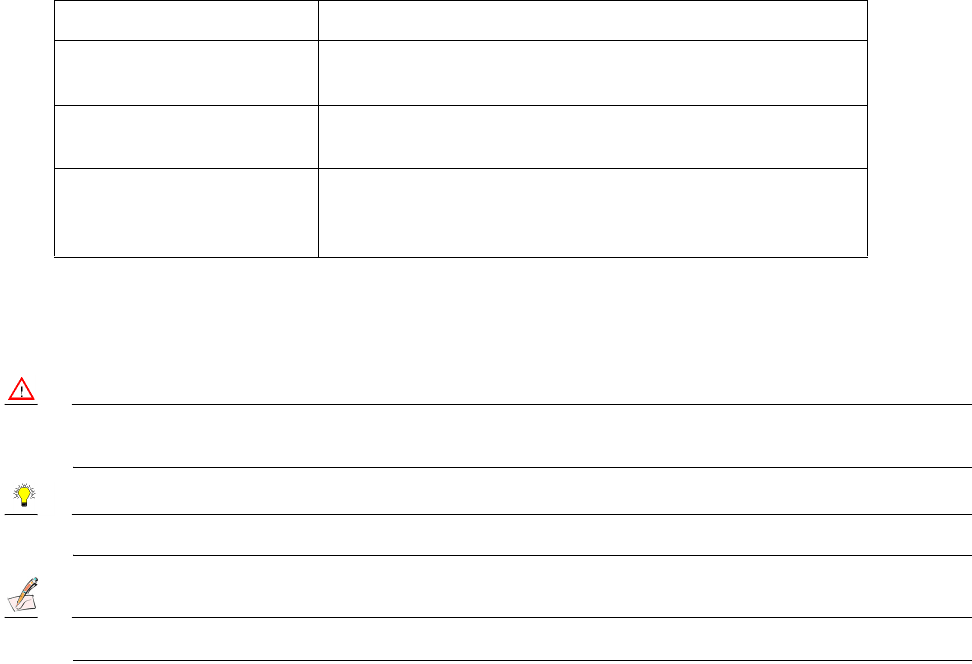
Page 4 SonicWALL SonicOS Standard Administrator’s Guide
Guide Conventions
The following Conventions used in this guide are as follows:
Icons Used in this Manual
These special messages refer to noteworthy information, and include a symbol for quick identification:
Alert!
Important information that cautions about features affecting firewall performance, security features, or
causing potential problems with your SonicWALL.
Tip!
Useful information about security features and configurations on your SonicWALL.
Note:
Important information on a feature that requires callout for special attention.
Convention Use
Bold Highlights items you can select on the SonicWALL
Management Interface.
Italic Highlights a value to enter into a field. For example, “type
192.168.168.168 in the IP Address field.”
Menu Item>Menu Item Indicates a multiple step Management Interface menu
choice. For example, “Security Services>Content Filter
means select Security Services, then select Content Filter.

Introduction Page 5
SonicWALL Technical Support
For timely resolution of technical support questions, visit SonicWALL on the Internet at
<http://www.sonicwall.com/services/support.html>. Web-based resources are available to help you
resolve most technical issues or contact SonicWALL Technical Support.
To contact SonicWALL telephone support, see the telephone numbers listed below:
North America Telephone Support
U.S./Canada - 888.777.1476 or +1 408.752.7819
International Telephone Support
Australia - + 1800.35.1642
Austria - + 43(0)820.400.105
EMEA - +31(0)411.617.810
France - + 33(0)1.4933.7414
Germany - + 49(0)1805.0800.22
Hong Kong - + 1.800.93.0997
India - + 8026556828
Italy - +39.02.7541.9803
Japan - + 81(0)3.5460.5356
New Zealand - + 0800.446489
Singapore - + 800.110.1441
Spain - + 34(0)9137.53035
Switzerland - +41.1.308.3.977
UK - +44(0)1344.668.484
Note:
Please visit <http://www.sonicwall.com/services/contact.html> for the latest technical support telephone
numbers.
More Information on SonicWALL Products and Services
Contact SonicWALL, Inc. for information about SonicWALL products and services at:
Web: http://www.sonicwall.com
E-mail: sales@sonicwall.com
Phone: (408) 745-9600
Fax:(408) 745-9300
Page 6 SonicWALL SonicOS Standard Administrator’s Guide

Page 7 SonicWALL SonicOS 2.2 Standard Administrator’s Guide
2 Internet Connectivity Using the Setup Wizard
The Setup Wizard takes you step by step through network configuration for Internet connectivity. There
are four types of network connectivity available: Static IP, DHCP, PPPoE, and PPTP.
The first time you log into the SonicWALL, the Setup Wizard is launched automatically. To launch the
Setup Wizard at any from the Management Interface, log into the SonicWALL. Click Wizards and select
Setup Wizard.
Note:
The Wizard pages shown in this chapter are for the SonicWALL TZ170 but they are identical to Wizard
pages for the PRO 2040 and PRO 3060.
Tip!
You can also configure all your WAN and network settings on the Network>Settings page of the
SonicWALL Management Interface
Configuring a Static IP Address with NAT Enabled
Using NAT to set up your SonicWALL eliminates the need for public IP addresses for all computers on
your LAN. It is a way to conserve IP addresses available from the pool of IPv4 addresses for the Internet.
NAT also allows you to conceal the addressing scheme of your network. If you do not have enough
individual IP addresses for all computers on your network, you can use NAT for your network
configuration.
Essentially, NAT translates the IP addresses in one network into those for a different network. As a form
of packet filtering for firewalls, it protects a network from outside intrusion from hackers by replacing the
internal (LAN) IP address on packets passing through a SonicWALL with a “fake” one from a fixed pool of
addresses. The actual IP addresses of computers on the LAN are hidden from outside view.
This section describes configuring the SonicWALL appliance in the NAT mode. If you are assigned a
single IP address by your ISP, follow the instructions below.
Tip!
: Be sure to have your network information including your WAN IP address, subnet mask, and DNS
settings ready. This information is obtained from your ISP.
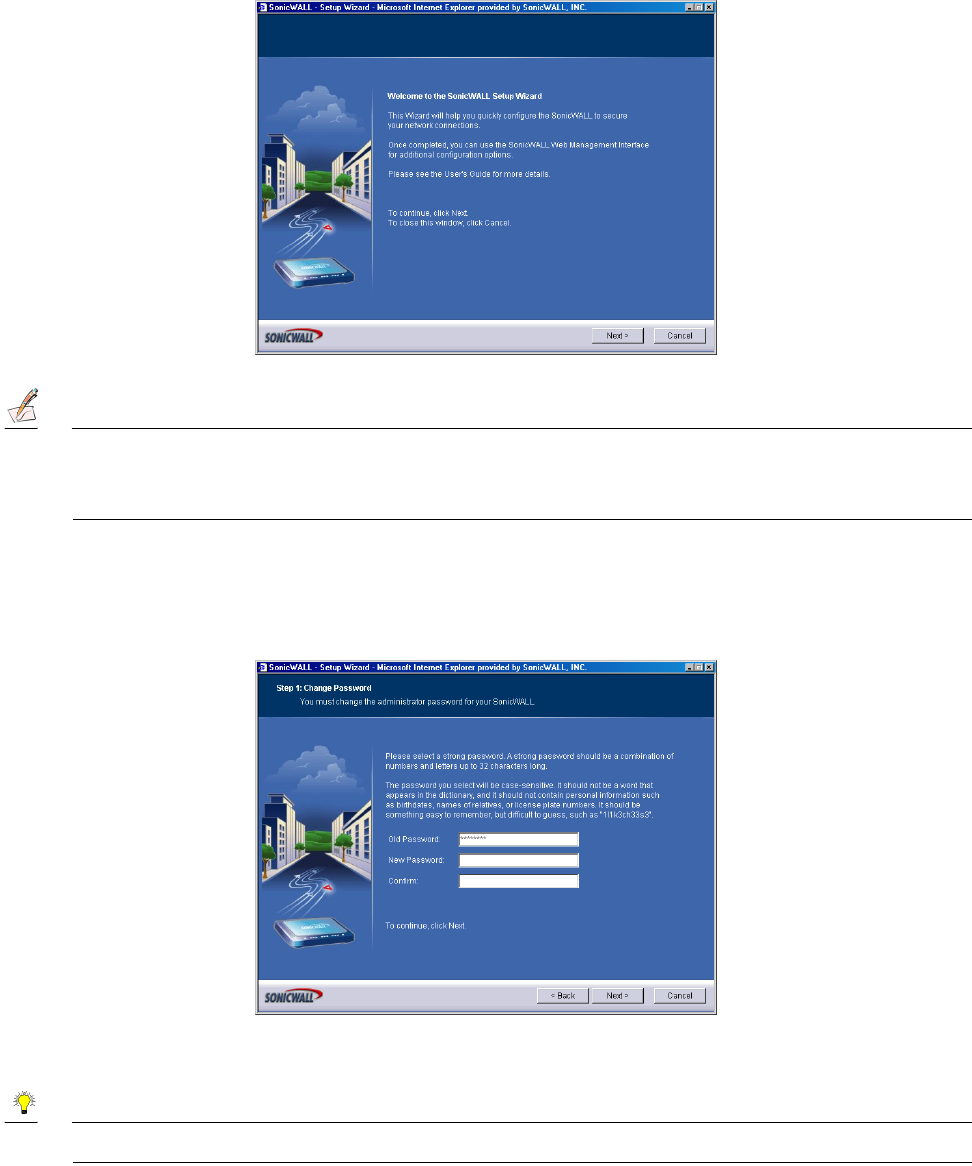
Page 8 SonicWALL SonicOS Standard Administrator’s Guide
Setup Wizard
Note:
Your Web browser must be Java-enabled and support HTTP uploads in order to fully manage
SonicWALL. Internet Explorer 5.0 and above as well as Netscape Navigator 4.0 and above are
recommended.
1. Click the Setup Wizard button on the Network>Settings page. Read the instructions on the
Welcome window and click Next to continue.
Step 1: Change Password
2. To set the password, enter a new password in the New Password and Confirm New Password
fields. Click Next.
Tip!
It is very important to choose a password which cannot be easily guessed by others.
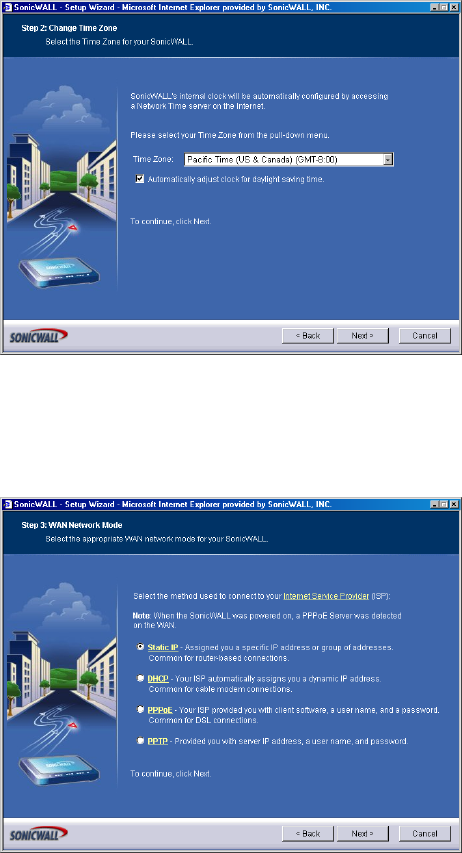
Internet Connectivity Using the Setup Wizard Page 9
Step 2: Change Time Zone
3. Select the appropriate Time Zone from the Time Zone menu. The SonicWALL internal clock is set
automatically by a Network Time Server on the Internet. Click Next.
Step 3: WAN Network Mode
4. Confirm that you have the proper network information necessary to configure the SonicWALL to
access the Internet. Click the hyperlinks for definitions of the networking terms.
You can choose:
•Static IP, if your ISP assigns you a specific IP address or group of addresses.
•DHCP, if your ISP automatically assigns you a dynamic IP address.
•PPPoE, if your ISP provided you with client software, a user name, and a password.
•PPTP, if your ISP provided you with a server IP address, a user name, and password.
5. Choose Static IP and click Next.
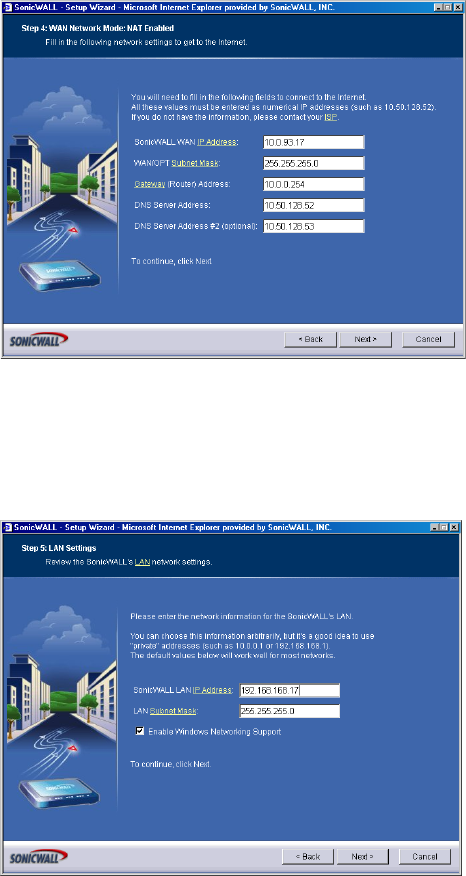
Page 10 SonicWALL SonicOS Standard Administrator’s Guide
Step 4: WAN Network Mode: NAT Enabled
6. Enter the public IP address provided by your ISP in the SonicWALL WAN IP Address, then fill in the
rest of the fields: WAN/OPT/DMZ Subnet Mask, WAN Gateway (Router) Address, and DNS Server
Addresses. Click Next.
Step 5: LAN Settings
7. The LAN page allows the configuration of the SonicWALL LAN IP Addresses and the LAN Subnet
Mask.The SonicWALL LAN IP Addresses are the private IP address assigned to the LAN port of
the SonicWALL. The LAN Subnet Mask defines the range of IP addresses on the LAN. The default
values provided by the SonicWALL work for most networks. If you do not use the default settings,
enter your preferred private IP address and subnet mask in the fields. Click Next.
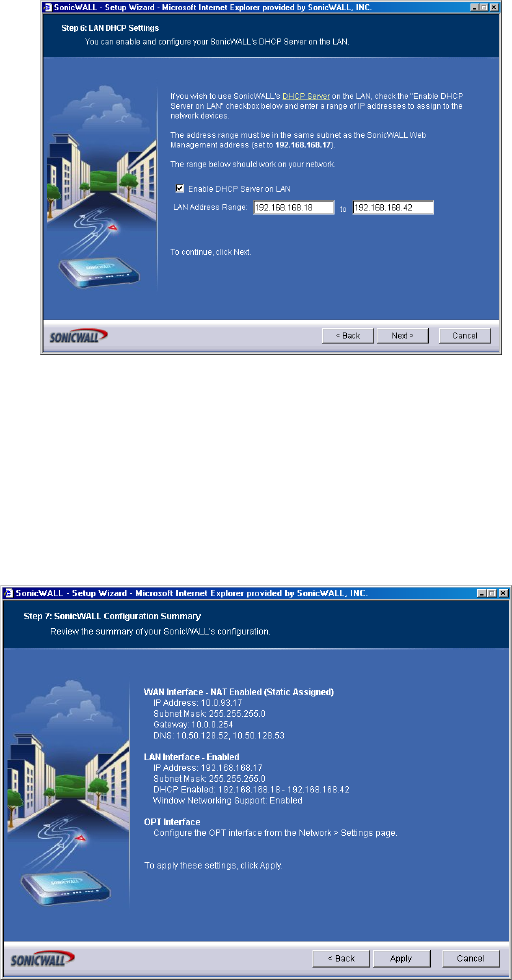
Internet Connectivity Using the Setup Wizard Page 11
Step 6: LAN DHCP Settings
8. The Optional-SonicWALL DHCP Server window configures the SonicWALL DHCP Server. If
enabled, the SonicWALL automatically configures the IP settings of computers on the LAN. To enable
the DHCP server, select Enable DHCP Server, and specify the range of IP addresses that are
assigned to computers on the LAN.
If Disable DHCP Server is selected, you must configure each computer on your network with a static
IP address on your LAN. Click Next.
Step 7: SonicWALL Configuration Summary
9. The Configuration Summary window displays the configuration defined using the Installation
Wizard. To modify any of the settings, click Back to return to the Connecting to the Internet window.
If the configuration is correct, click Next.
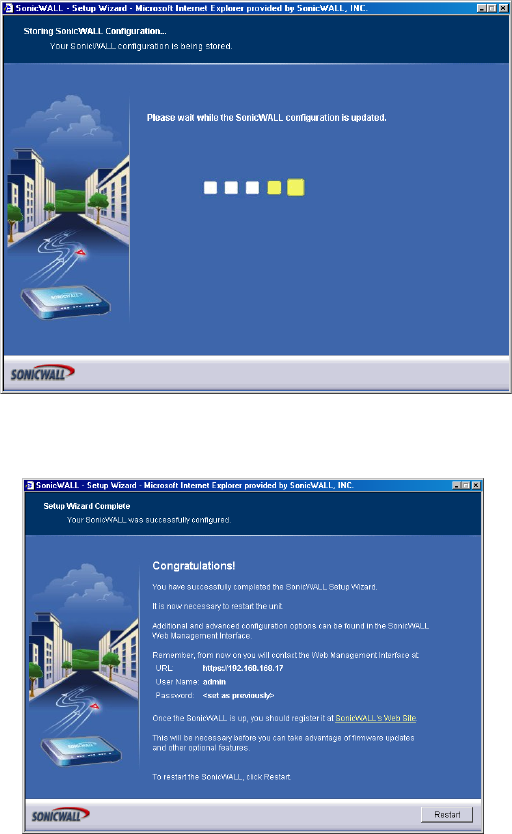
Page 12 SonicWALL SonicOS Standard Administrator’s Guide
Storing SonicWALL Configuration
Setup Wizard Complete
10. The SonicWALL stores the network settings.
11. Click Restart to restart the SonicWALL. The SonicWALL takes approximately 90 seconds or longer
to restart. During this time, the yellow Test LED is lit.
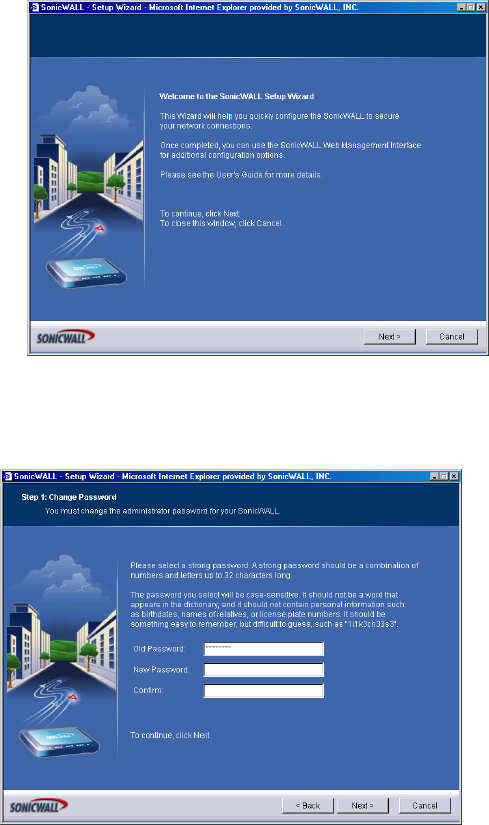
Internet Connectivity Using the Setup Wizard Page 13
Configuring DHCP Networking Mode
DHCP is a networking mode that allows you to obtain an IP address for a specific length of time from a
DHCP server. The length of time is called a lease which is renewed by the DHCP server typically after a
few days. When the lease is ready to expire, the client contacts the server to renew the lease. This is a
common network configuration for customers with cable or DSL modems. You are not assigned a specific
IP address by your ISP.
1. Click the Setup Wizard button on the Network>Settings page.
2. Read the instructions on the Welcome window and click Next to continue.
Step 1: Change Password
3. To set the password, enter a new password in the New Password and Confirm New Password
fields. Click Next.
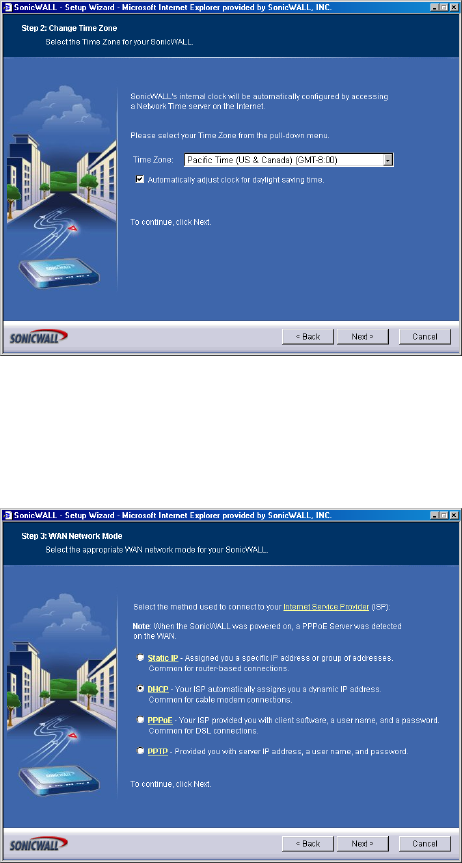
Page 14 SonicWALL SonicOS Standard Administrator’s Guide
Step 2: Change Time Zone
4. Select the appropriate Time Zone from the Time Zone menu. The SonicWALL internal clock is set
automatically by a Network Time Server on the Internet. Click Next.
Step 3: WAN Network Mode
5. Select DHCP, the Obtain an IP address automatically window is displayed. Click Next.
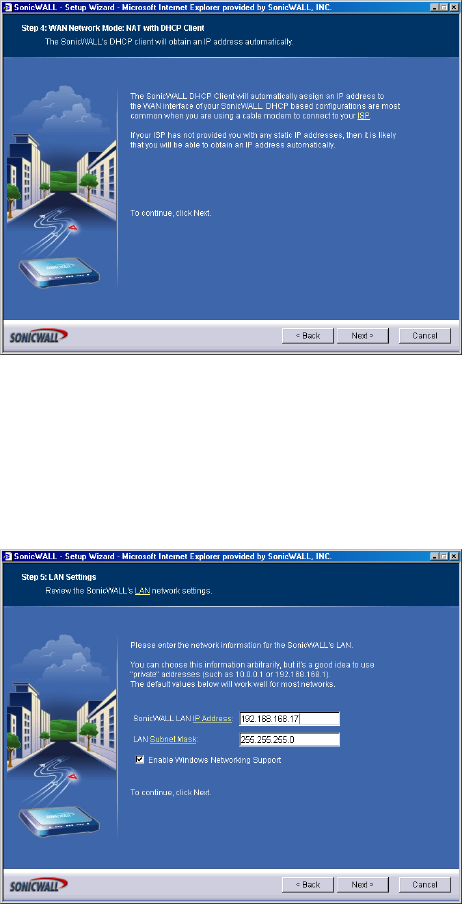
Internet Connectivity Using the Setup Wizard Page 15
Step 4: WAN Network Mode: NAT with DHCP Client
6. The Obtain an IP address automatically window states that the ISP dynamically assigns an IP
address to the SonicWALL. To confirm this, click Next. DHCP-based configurations are most
common with cable modem connections.
Step 5: LAN Settings
7. The Fill in information about your LAN page allows the configuration of SonicWALL LAN IP
Addresses and Subnet Masks. SonicWALL LAN IP Addresses are the private IP addresses assigned
to the LAN of the SonicWALL. The LAN Subnet Mask defines the range of IP addresses on the
networks. The default values provided by the SonicWALL are useful for most networks. Click Next.
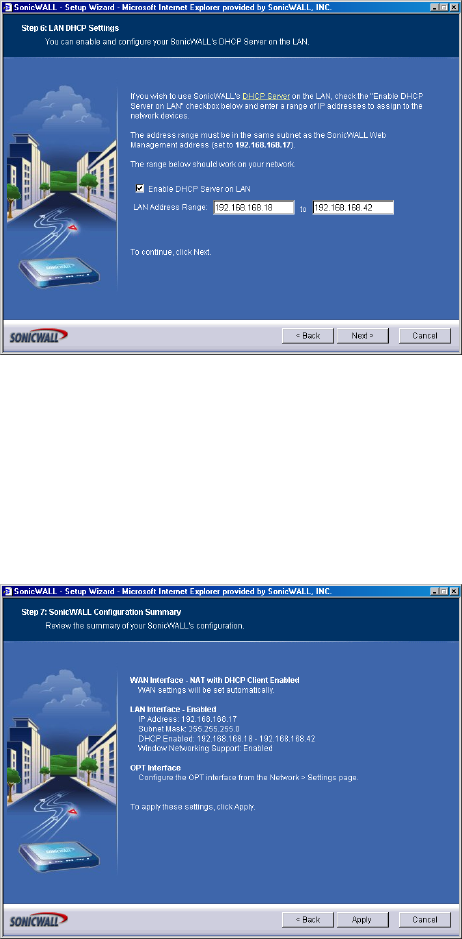
Page 16 SonicWALL SonicOS Standard Administrator’s Guide
Step 6: DHCP Settings
8. The Optional-SonicWALL DHCP Server window configures the SonicWALL DHCP Server. If
enabled, the SonicWALL automatically assigns IP settings to computers on the LAN. To enable the
DHCP server, select Enable DHCP Server, and specify the range of IP addresses assigned to
computers on the LAN.
If Disable DHCP Server is selected, the DHCP Server is disabled. Click Next to continue.
Configuration Summary
9. The Configuration Summary window displays the configuration defined using the Installation
Wizard. To modify any of the settings, click Back to return to the Connecting to the Internet window.
If the configuration is correct, click Apply.
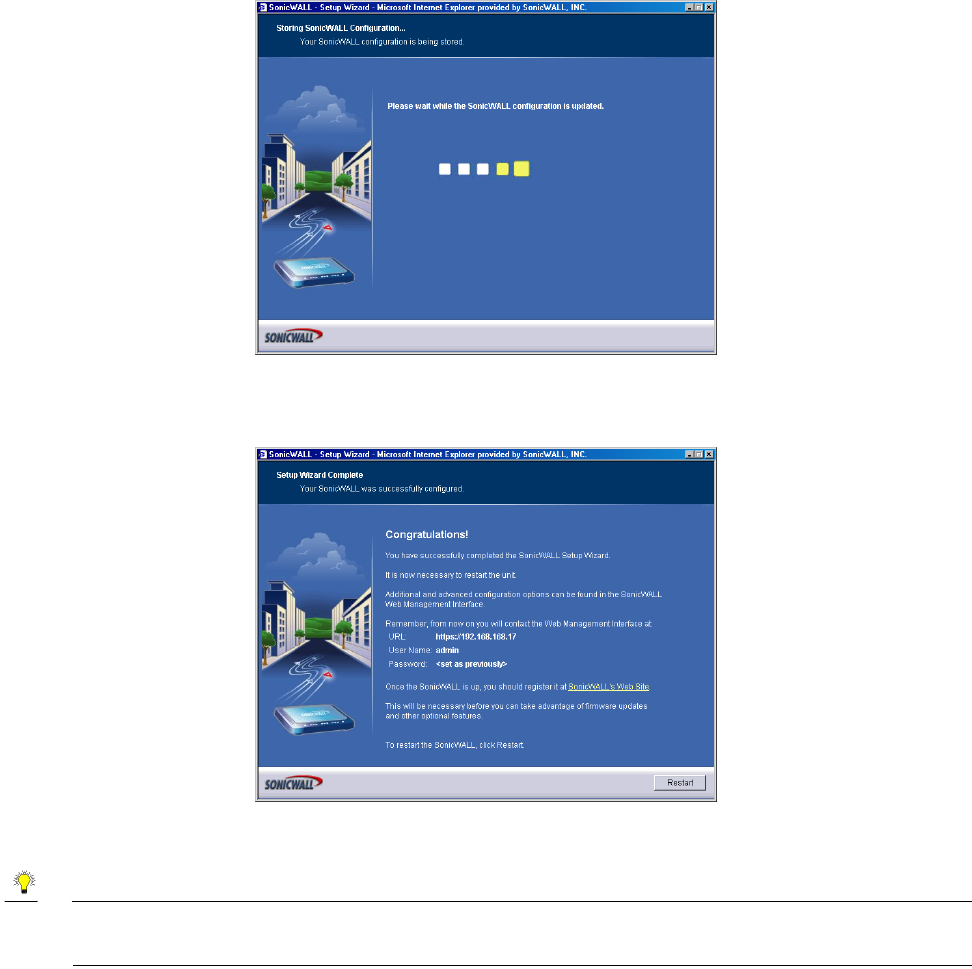
Internet Connectivity Using the Setup Wizard Page 17
Storing SonicWALL Configuration
Setup Wizard Complete
10. Click Restart to restart the SonicWALL. The SonicWALL takes 90 seconds to restart. During this time,
the yellow Test LED is lit.
Tip!
The new SonicWALL LAN IP address, displayed in the URL field of the Congratulations window, is
used to log in and manage the SonicWALL.
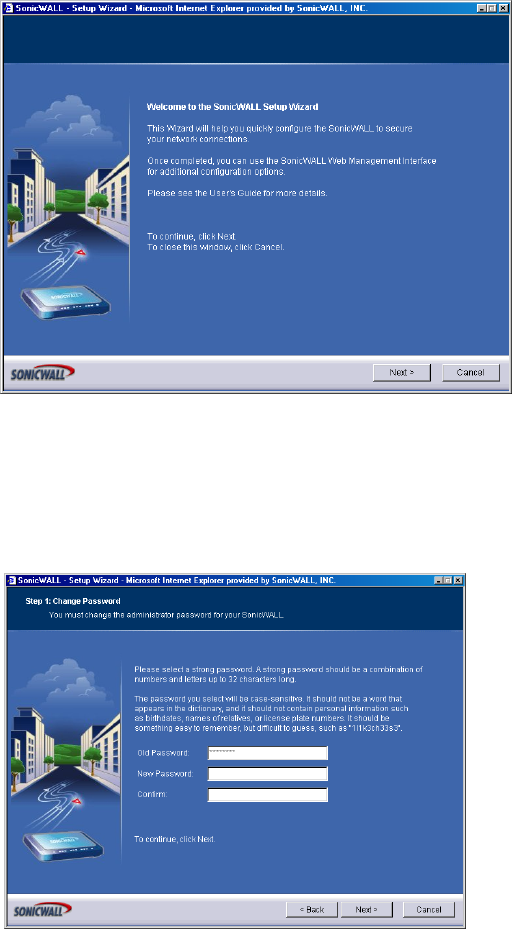
Page 18 SonicWALL SonicOS Standard Administrator’s Guide
Configuring NAT Enabled with PPPoE
NAT with PPPoE Client is a network protocol that uses Point to Point Protocol over Ethernet to connect
with a remote site using various Remote Access Service products. This protocol is typically found when
using a DSL modem with an ISP requiring a user name and password to log into the remote server. The
ISP may then allow you to obtain an IP address automatically or give you a specific IP address.
1. Click the Setup Wizard button on the Network>Settings page.
2. Read the instructions on the Welcome window and click Next to continue.
Step 1: Change Password
3. To set the password, enter a new password in the New Password and Confirm New Password
fields. Click Next.
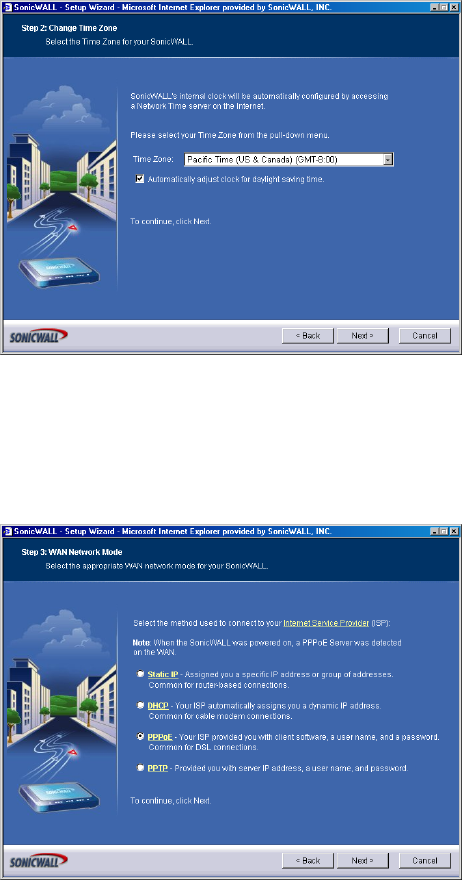
Internet Connectivity Using the Setup Wizard Page 19
Step 2: Change Time Zone
4. Select the appropriate Time Zone from the Time Zone menu. The SonicWALL internal clock is set
automatically by a Network Time Server on the Internet. Click Next.
Step 3: WAN Network Mode
5. The SonicWALL automatically detects the presence of a PPPoE server on the WAN. If not, then
select PPPoE: Your ISP provided you with desktop software, a user name and password. Click
Next.
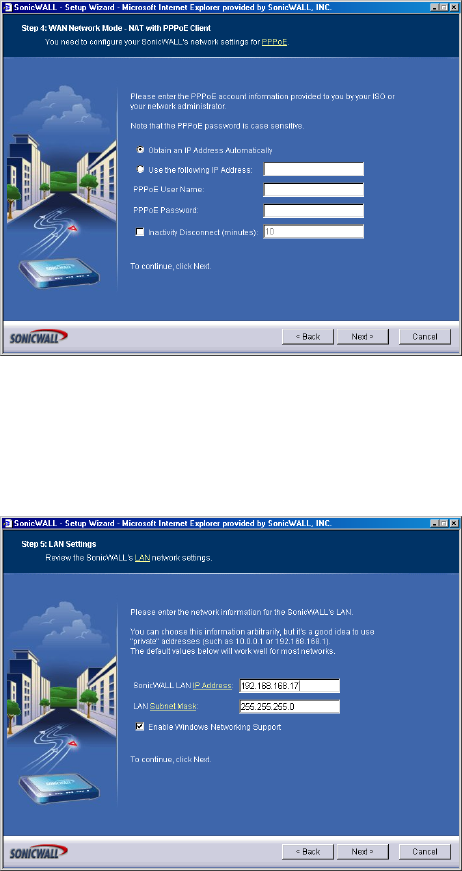
Page 20 SonicWALL SonicOS Standard Administrator’s Guide
Step 4: WAN Network Mode: NAT with PPPoE Client
6. Enter the user name and password provided by your ISP into the User Name and Password fields.
Click Next.
Step 5: LAN Settings
7. The LAN Settings page allows the configuration of SonicWALL LAN IP Addresses and LAN Subnet
Mask.The SonicWALL LAN IP Address is the private IP address assigned to the LAN port of the
SonicWALL. The LAN Subnet Mask defines the range of IP addresses on the LAN. The default
values provided by the SonicWALL are useful for most networks. If you do not use the default settings,
enter your preferred IP addresses in the fields. Click Next.
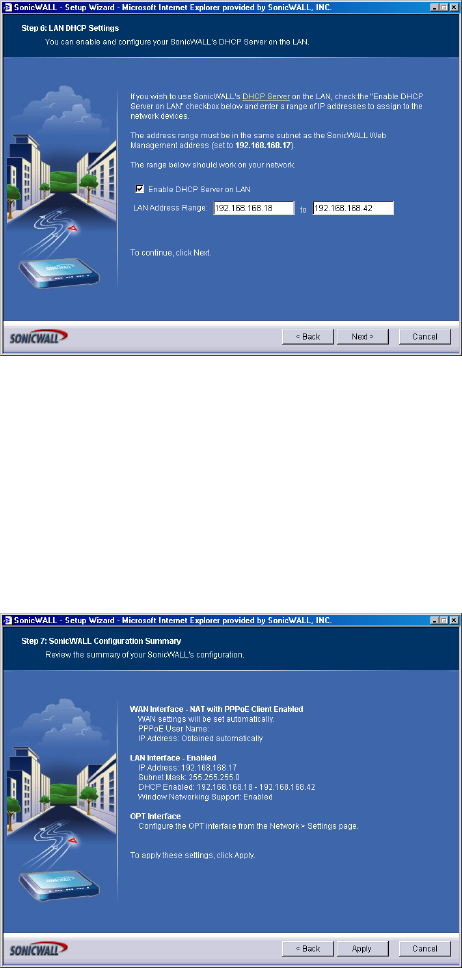
Internet Connectivity Using the Setup Wizard Page 21
Step 6: DHCP Server
8. The Optional-SonicWALL DHCP Server window configures the SonicWALL DHCP Server. If
enabled, the SonicWALL automatically assigns IP settings to computers on the LAN. To enable the
DHCP server, select Enable DHCP Server, and specify the range of IP addresses that are assigned
to computers on the LAN.
If Disable DHCP Server is selected, you must configure each computer on your network with a static
IP address on your LAN. Click Next.
Step 7: SonicWALL Configuration Summary
9. The Configuration Summary window displays the configuration defined using the Installation
Wizard. To modify any of the settings, click Back to return to the WAN Settings window. If the
configuration is correct, click Next to proceed to the Congratulations window.
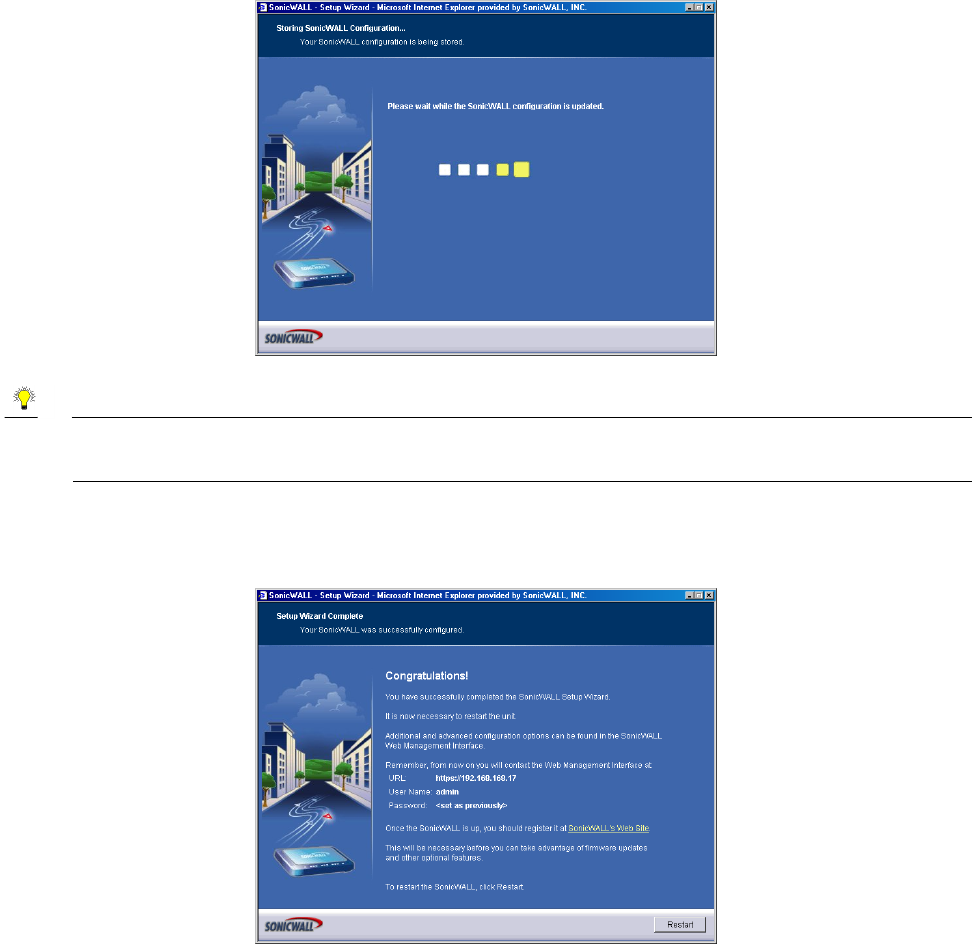
Page 22 SonicWALL SonicOS Standard Administrator’s Guide
Storing SonicWALL Configuration
Tip!
The new SonicWALL LAN IP address, displayed in the URL field of the Congratulations window, is
used to log in and manage the SonicWALL.
Setup Wizard Complete
10. Click Restart to restart the SonicWALL.
11. The SonicWALL takes approximately 90 seconds or longer to restart. During this time, the yellow Test
LED is lit.
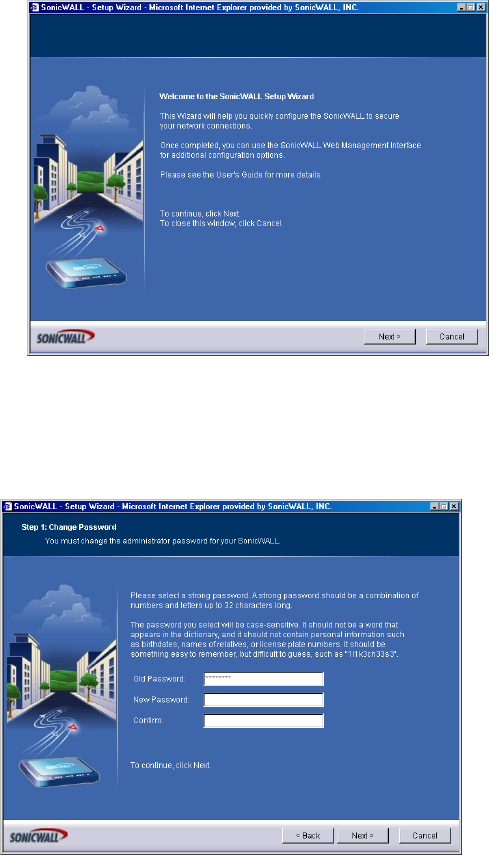
Internet Connectivity Using the Setup Wizard Page 23
Configuring PPTP Network Mode
NAT with PPTP Client mode uses Point to Point Tunneling Protocol (PPTP) to connect to a remote
server. It supports older Microsoft implementations requiring tunneling connectivity.
1. Click the Setup Wizard button on the Network>Settings page.
2. Read the instructions on the Welcome window and click Next to continue.
Step 1: Change Password
3. To set the password, enter a new password in the New Password and Confirm New Password
fields. Click Next.
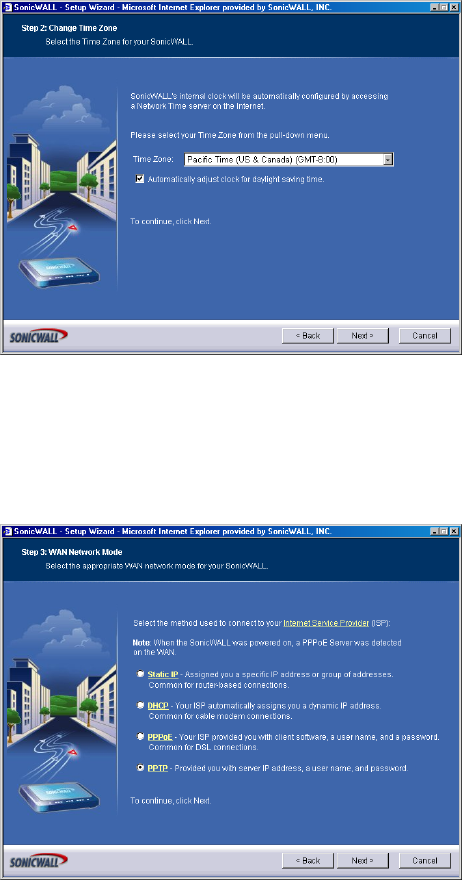
Page 24 SonicWALL SonicOS Standard Administrator’s Guide
Step 2: Change Time Zone
4. Select the appropriate Time Zone from the Time Zone menu. The SonicWALL internal clock is set
automatically by a Network Time Server on the Internet. Click Next.
Step 3: WAN Network Mode
5. Select PPTP: Provided you with a server IP address, a user name and password. Click Next.
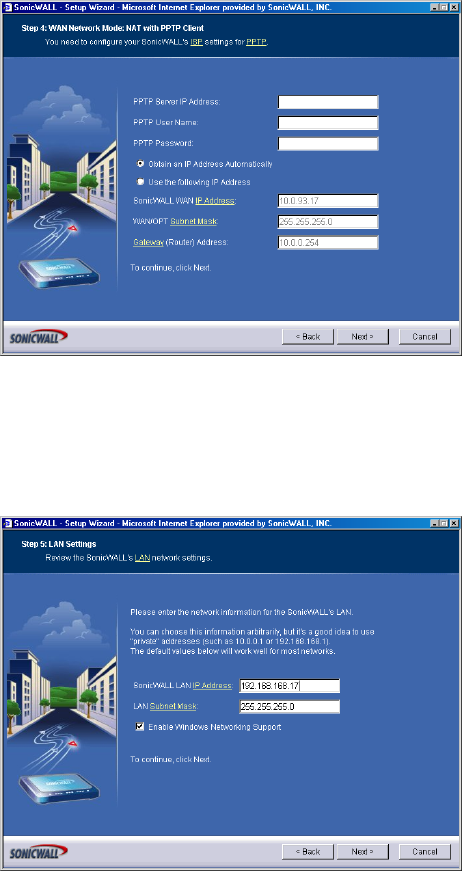
Internet Connectivity Using the Setup Wizard Page 25
Step 4: WAN Network Mode: NAT with PPTP Client
6. Enter the user name and password provided by your ISP into the User Name and Password fields.
Click Next.
Step 5: LAN Settings
7. The LAN Settings page allows the configuration of SonicWALL LAN IP Addresses and LAN Subnet
Mask.The SonicWALL LAN IP Address is the private IP address assigned to the LAN port of the
SonicWALL. The LAN Subnet Mask defines the range of IP addresses on the LAN. The default
values provided by the SonicWALL are useful for most networks. If you do not use the default settings,
enter your preferred IP addresses in the fields. Click Next.
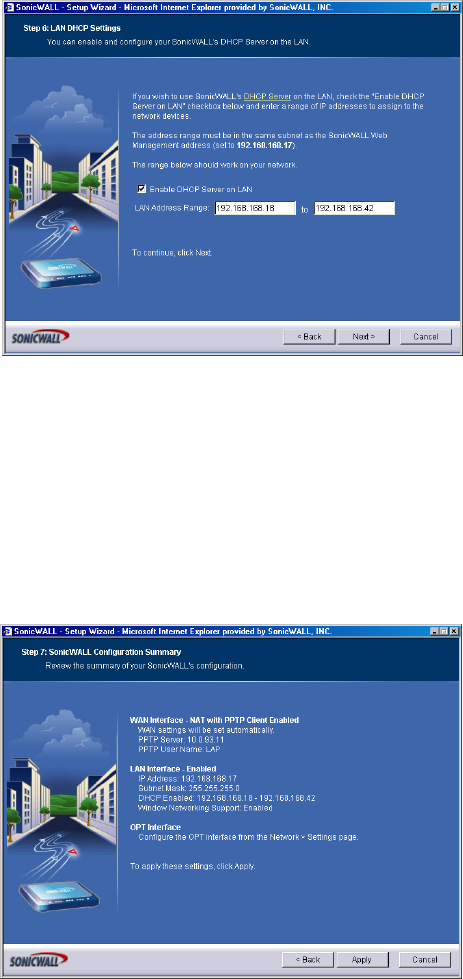
Page 26 SonicWALL SonicOS Standard Administrator’s Guide
Step 6: DHCP Server
8. The Optional-SonicWALL DHCP Server window configures the SonicWALL DHCP Server. If
enabled, the SonicWALL automatically assigns IP settings to computers on the LAN. To enable the
DHCP server, select Enable DHCP Server, and specify the range of IP addresses that are assigned
to computers on the LAN.
If Disable DHCP Server is selected, you must configure each computer on your network with a static
IP address on your LAN. Click Next.
Step 7: SonicWALL Configuration Summary
9. The Configuration Summary window displays the configuration defined using the Installation
Wizard. To modify any of the settings, click Back to return to the Connecting to the Internet window.
If the configuration is correct, click Next to proceed to the Storing SonicWALL Configuration
window.
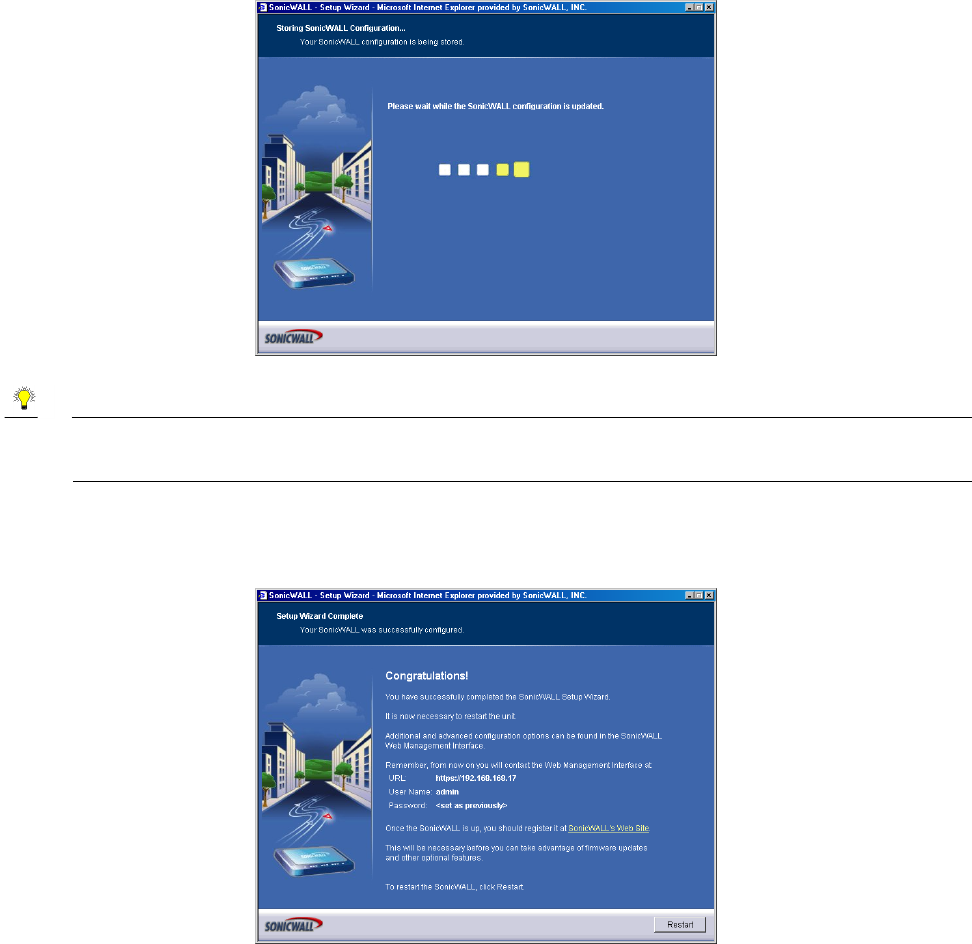
Internet Connectivity Using the Setup Wizard Page 27
Storing SonicWALL Configuration
Tip!
The new SonicWALL LAN IP address, displayed in the URL field of the Congratulations window, is
used to log in and manage the SonicWALL.
Setup Wizard Complete
10. Click Restart to restart the SonicWALL. The SonicWALL takes approximately 90 seconds or longer
to restart. During this time, the yellow Test LED is lit.
Page 28 SonicWALL SonicOS Standard Administrator’s Guide
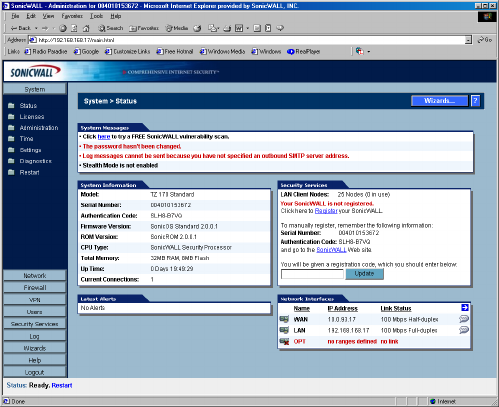
System Settings Page 29
3 System Settings
This chapter describes the configuration of the SonicWALL IP settings, time, and password as well as
providing instructions to restart the SonicWALL, import and export settings, upload new firmware, and
perform diagnostic tests.
System>Status
The Status page contains five sections: System Messages, System Information, Latest Alerts,
Security Services, and Network Interfaces.
System Messages
Any information considered relating to possible problems with configurations on the SonicWALL such as
password, log messages, etc.
System Information
The following information is displayed in this section:
•Model - type of SonicWALL product
•Serial Number - also the MAC address of the SonicWALL
•Authentication Code - the alphanumeric code used to authenticate the SonicWALL on the registra-
tion database at <https://www.mysonicwall.com>.
•Firmware Version - the firmware version loaded on the SonicWALL.
•ROM Version - indicates the ROM version.
•CPU Type - displays the type and speed of the SonicWALL processor.
•Total Memory - indicates the amount of RAM and flash memory.
•Uptime - the length of time, in days, hours, and seconds the SonicWALL is active.
•Current Connections - the number of network connections currently existing on the
SonicWALL.
•Registration Code - the registration code is generated when your SonicWALL is
registered at <http://www.mysonicwall.com>.

Page 30 SonicWALL SonicOS Standard Administrator’s Guide
Security Services
A list of available SonicWALL Security Services are listed in this section with the status of Licensed or
Not Licensed. If Licensed, the Status column displays the number of licenses and the number of
licenses in use. Clicking the Arrow icon displays the System>Licenses page in the SonicWALL Web
Management Interface. SonicWALL Security Services and Internet Security Appliance registration is
managed by mySonicWALL.com.
Registering Your SonicWALL
If your SonicWALL is not registered at mySonicWALL.com, the following message is displayed in the
Security Services folder: Your SonicWALL is not registered. Click here to Register your SonicWALL.
Note:
You need a mySonicWALL.com account to register your SonicWALL or activate security services. You
can create a mySonicWALL.com account directly from the SonicWALL Management Interface.
You can manually register your SonicWALL at the mySonicWALL.com site using the Serial Number and
Authentication Code displayed in the Security Services folder. Click the SonicWALL link to access your
mySonicWALL.com account. You will be given a registration code after you have registered your
SonicWALL. Enter the registration code in the field below You will be given a registration code, which
you should enter below, then click Update.
If you have a mySonicWALL.com account, follow these steps to register your SonicWALL:
1. Click the here link to automatically register your SonicWALL. The mySonicWALL.com Login page
is displayed.
2. Type your mySonicWALL.com username and password in the User Name and Password fields and
click Submit.
3. Type in a “friendly name” for your SonicWALL in the Friendly Name field. A friendly name is used to
help identify your SonicWALL, such as its location.
4. Click Submit. Your SonicWALL is now registered.
mySonicWALL.com
mySonicWALL.com delivers a convenient, one-stop resource for registration, activation, and
management of your SonicWALL products and services. Your mySonicWALL.com account provides a
single profile to do the following:
• Register your SonicWALL Internet Security Appliances
• Purchase/Activate SonicWALL Security Services and Upgrades
• Receive SonicWALL firmware and security service updates and alerts
• Manage (change or delete) your SonicWALL security services
• Access SonicWALL Technical Support
Creating a mySonicWALL.com account is easy and free. Simply complete an online registration form.
Once your account is created, you can register SonicWALL Internet Security Appliances and activate any
SonicWALL Security Services associated with the SonicWALL.
Your mySonicWALL.com account is accessible from any Internet connection with a Web browser using
the HTTPS (Hypertext Transfer Protocol Secure) protocol to protect your sensitive information. You can
also access mySonicWALL.com license and registration services directly from the SonicWALL
management interface for increased ease of use and simplified services activation.
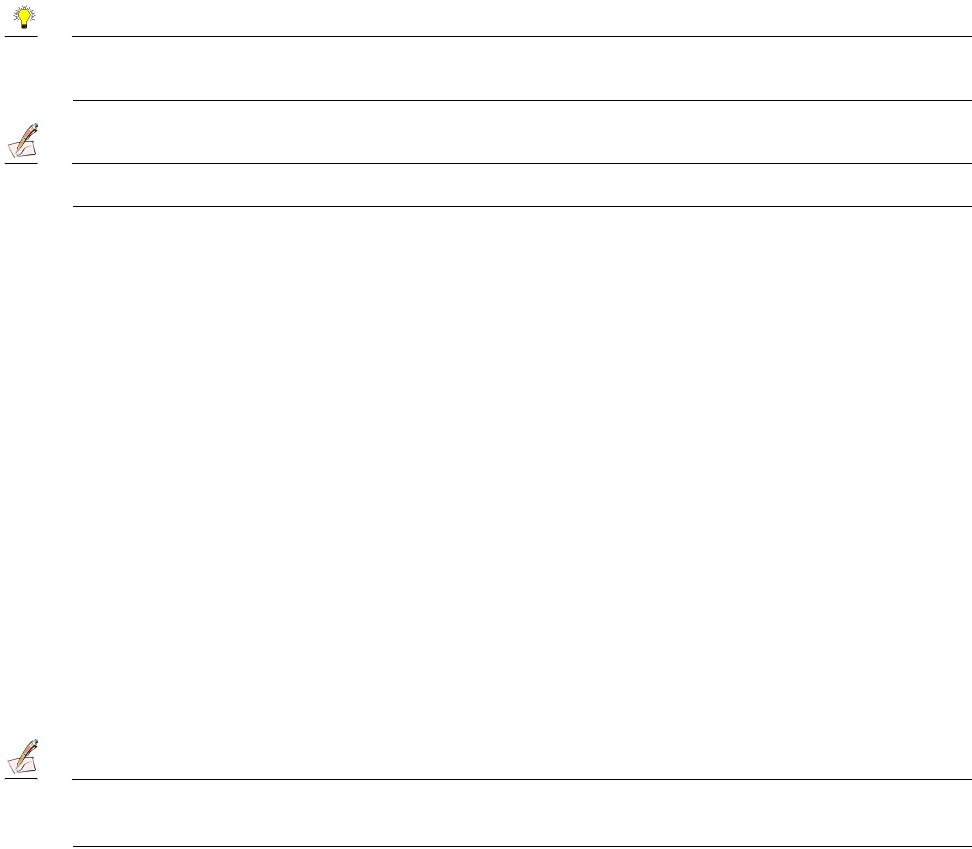
System Settings Page 31
Tip!
For more information on mySonicWALL.com, access the online help available at
https://www.mysonicwall.com.
Note:
mySonicWALL.com registration information is not sold or shared with any other company.
Latest Alerts
Any messages relating to system errors or attacks are displayed in this section. Attack messages include
AV Alerts, forbidden e-mail attachments, fraudulent certificates, etc. System errors include WAN IP
changed and encryption errors. Clicking the blue arrow displays the Log>Log View page.
Network Interfaces
The following information is contained in this section:
•WAN - network speed, for example 100 Mbps, and devices connected to the WAN link.
•LAN - network speed and network address mode
•OPT/DMZ - network speed and network address mode
Clicking the arrow displays the Network>Settings page.
System>Licenses
The System>Licenses page provides links to activate, upgrade, or renew SonicWALL Security Services
and upgrades.
Note:
For more information on SonicWALL Security Services and Upgrades, visit
<http://www.sonicwall.com>
Security Services Summary
The Security Services Summary table lists the available and activated security services on the
SonicWALL. The Security Service column lists all the available SonicWALL security services and
upgrades available for the SonicWALL. The Status column indicates is the security service is activated
(Licensed), available for activation (Not Licensed), or no longer active (Expired). The number of nodes/
users allowed for the license is displayed in the Count column.
The information listed in the Security Services Summary table is updated from your mySonicWALL.com
account the next time the SonicWALL automatically synchronizes with your mySonicWALL.com account
(once a day) or you can click the link in To synchronize licenses with mySonicWALL.com click here
in the Manage Security Services Online section.
Manage Security Services Online
To activate, upgrade, or renew services, click the link in To Activate, Upgrade, or Renew services, click
here. Click the link in To synchronize licenses with mySonicWALL.com click here to synchronize
your mySonicWALL.com account with the Security Services Summary table.
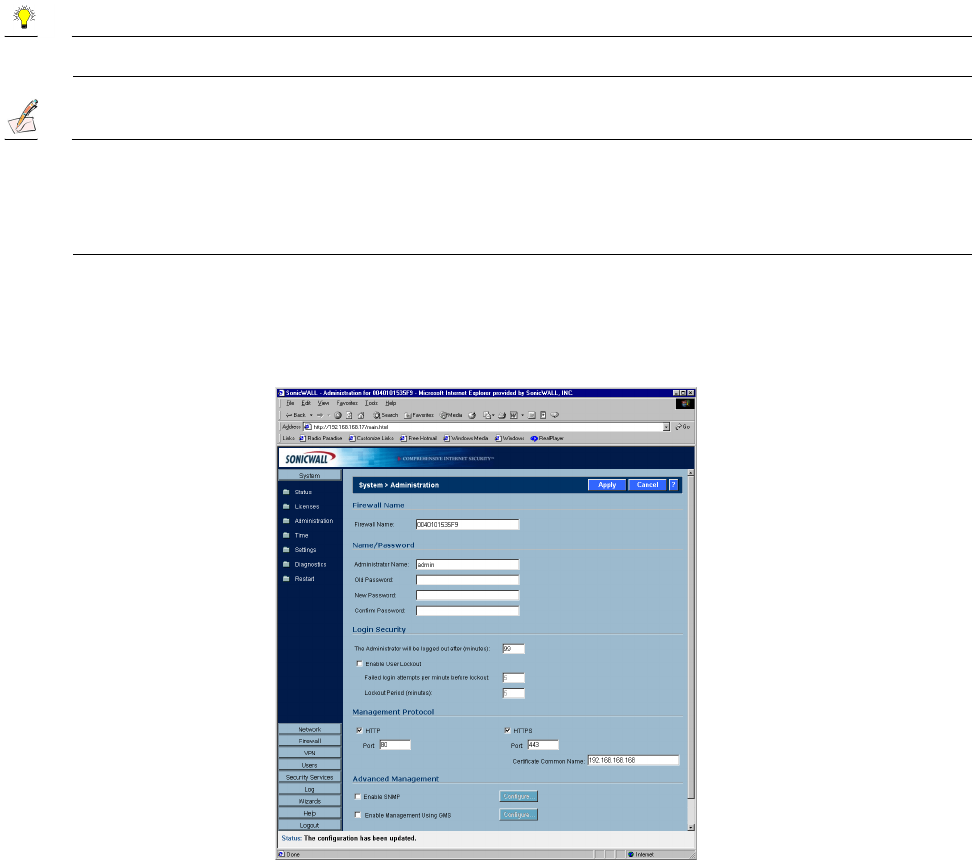
Page 32 SonicWALL SonicOS Standard Administrator’s Guide
You can also get free trial subscriptions to SonicWALL Content Filter Service and Network Anti-Virus by
clicking the For Free Trials click here link. When you click these links, the mySonicWALL.com Login
page is displayed. Enter your mySonicWALL.com account username and password in the User Name
and Password fields and click Submit. The Manage Services Online page is displayed with licensing
information from your mySonicWALL.com account.
Manual Upgrade
Manual Upgrade allows you to activate your services by typing the service activation key supplied with
the service subscription not activated on mySonicWALL.com. Type the activation key from the product
into the Enter upgrade key field and click Submit.
Tip!
You must have a mysonicwall.com account to upgrade and activate services through the SonicWALL.
Note:
If your SonicWALL is deployed in a high-security environment that does not allow direct Internet
connectivity from the SonicWALL, you can enter the encrypted license key information manually in the
enter keyset field. See the SonicWALL TechNote Manual Upgrades for Closed Environments using
License Keyset at <www.sonicwall.com/services/SonicOS_FW_documentation.html for instructions.
System>Administration
Firewall Name
The Firewall Name uniquely identifies the SonicWALL and defaults to the serial number of the
SonicWALL. The serial number is also the MAC address of the unit. The Firewall Name is mainly used in
e-mailed log files. To change the Firewall Name, enter a unique alphanumeric name in the Firewall Name
field. It must be at least 8 characters in length.
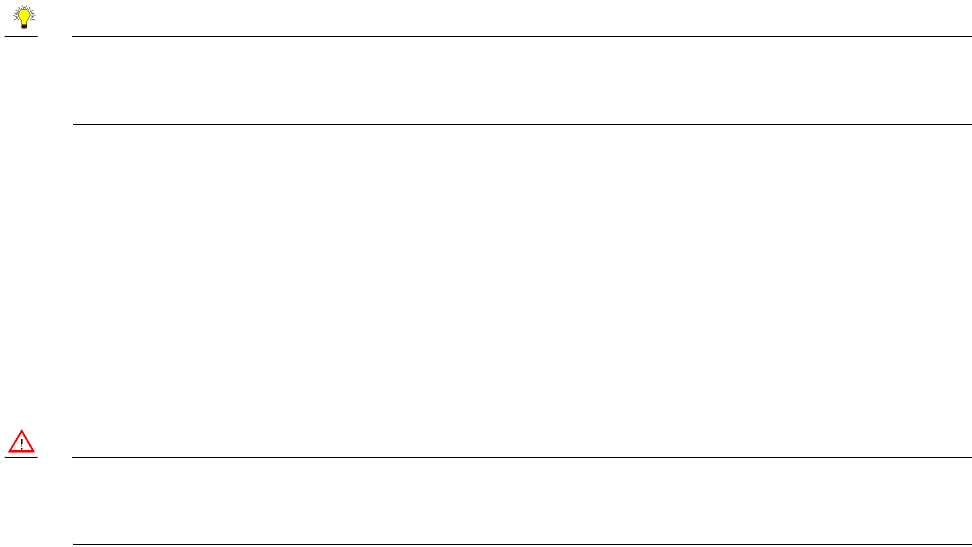
System Settings Page 33
Name/Password
Administrator Name
The Administrator Name can be changed from the default setting of admin to any word using
alphanumeric characters up to 32 characters in length. To create an new administrator name, enter the
new name in the Administrator Name field. Click Apply for the changes to take effect on the SonicWALL.
Changing the Administrator Password
To set the password, enter the old password in the Old Password field, and the new password in the New
Password field. Enter the new password again in the Confirm New Password field and click Apply.
Once the SonicWALL has been updated, a message confirming the update is displayed at the bottom of
the browser window.
Login Security
The Administrator Inactivity Timeout setting allows you to set the length of inactivity time that elapses
before you are automatically logged out of the Web Management Interface. By default, the SonicWALL
logs out the administrator after 5 minutes of inactivity.
Tip!
If the Administrator Inactivity Timeout is extended beyond 5 minutes, you should end every
management session by clicking Logout to prevent unauthorized access to the SonicWALL Web
Management Interface.
Enter the desired number of minutes in the Administrator Inactivity Timeout section and click Update.
The Inactivity Timeout can range from 1 to 99 minutes. Click Apply, and a message confirming the
update is displayed at the bottom of the browser window.
Enable Administrator/User Lockout
You can configure the SonicWALL to lockout an administrator or a user if the login credentials are
incorrect. Select the Enable Administrator/User Lockout check box to prevent users from attempting to
log into the SonicWALL without proper authentication credentials. Enter the number of failed attempts
before the user is locked out in the Lock out user after __ failed login attempts in a 1 minute period
field. Enter the length of time that must elapse before the user attempts to log into the SonicWALL again
in the Lockout Period (minutes) field.
Alert!
If the administrator and a user are logging into the SonicWALL using the same source IP address, the
administrator is also locked out of the SonicWALL. The lockout is based on the source IP address of
the user or administrator.
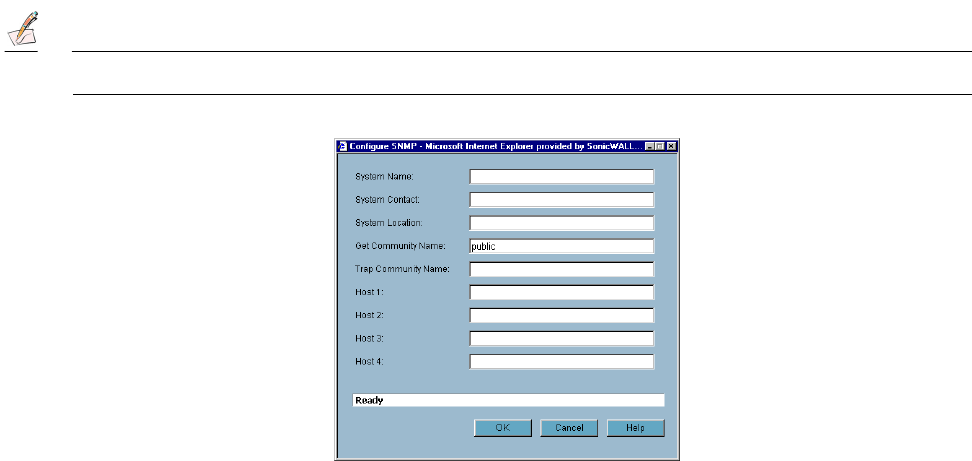
Page 34 SonicWALL SonicOS Standard Administrator’s Guide
Management Protocol
The SonicWALL can be managed using HTTP or HTTPS and a Web browser. Both HTTP and HTTPS
are enabled by default. The default port for HTTP is port 80, but you can configure access through another
port. Enter the number of the desired port in the Port field, and click Update. However, if you configure
another port for HTTP management, you must include the port number when you use the IP address to
log into the SonicWALL. For example, if you configure the port to be 76, then you must enter <LAN IP
Address>:76 into the Web browser, i.e. <http://192.168.168.1:76>
The default port for HTTPS management is 443, the standard port. You can add another layer of security
for logging into the SonicWALL by changing the default port. To configure another port for HTTPS
management, enter the preferred port number into the Port field, and click Update. For example, if you
configure the HTTPS Management Port to be 700, then you must log into the SonicWALL using the port
number as well as the IP address, for example,
<https://192.168.168.1:700> to access the SonicWALL.
The Certificate Common Name field defaults to the SonicWALL LAN Address. This allows you to
continue using a certificate without downloading a new one each time you log into the SonicWALL.
Advanced Management
Enable SNMP
SNMP (Simple Network Management Protocol) is a network protocol used over User Datagram Protocol
(UDP) that allows network administrators to monitor the status of the SonicWALL and receive notification
of critical events as they occur on the network. The SonicWALL supports SNMP v1/v2c and all relevant
Management Information Base II (MIB) groups except egp and at. The SonicWALL replies to SNMP Get
commands for MIBII via any interface and supports a custom SonicWALL MIB for generating trap
messages. The custom SonicWALL MIB is available for download from the SonicWALL Web site and can
be loaded into third-party SNMP management software such as HP Openview, Tivoli, or SNMPC.
To enable SNMP on the SonicWALL, select the Enable SNMP check box, and then click Configure in
the System>Administration page.
Note:
v1 traps are not supported on the SonicWALL.
1. Enter the host name of the SonicWALL in the System Name field.
2. Enter the network administrator’s name in the System Contact field.
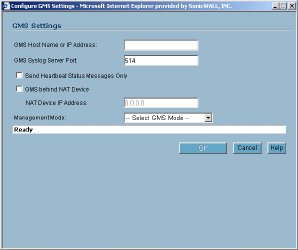
System Settings Page 35
3. Enter an e-mail address, telephone number, or pager number in the System Location field.
4. Enter a name for a group or community of administrators who can view SNMP data in the Get
Community Name field.
5. Enter a name for a group or community of administrators who can view SNMP traps in the Trap
Community Name field.
6. Enter the IP address or host name of the SNMP management system receiving SNMP traps in the
Host 1 through Host 4 fields. You must configure at least one IP address or host name, but up to four
addresses or host names can be used.
7. Click OK.
Trap messages are generated only for the alert message categories normally sent by the SonicWALL.
For example, attacks, system errors, or blocked Web sites generate trap messages. If none of the
categories are selected on the Log>Settings page, then no trap messages are generated.
By default, the SonicWALL responds only to Get SNMP messages received on its LAN interface.
Appropriate rules must be configured to allow SNMP traffic to and from the WAN interface. SNMP trap
messages can be sent via the LAN or WAN. See Chapter 5, Firewall, for instructions on adding services
and rules to the SonicWALL.
If your SNMP management system supports discovery, the SonicWALL agent automatically discover the
SonicWALL appliance on the network. Otherwise, you must add the SonicWALL to the list of SNMP-
managed devices on the SNMP management system.
Enable Management Using SonicWALL GMS
To enable the SonicWALL to be managed by SonicWALL Global Management System (GMS). Select the
Enable Management using GMS checkbox, then click Configure. The Configure GMS Settings
window is displayed.
To configure the SonicWALL for GMS management:
1. Enter the host name or IP address of the GMS Console in the GMS Host Name or IP Address field.
2. Enter the port in the GMS Syslog Server Port field. The default value is 514.
3. Select Send Heartbeat Status Messages Only to send only heartbeat status instead of log
messages.
4. Select GMS behind NAT Device if the GMS Console is placed behind a device using NAT on the
network. Type the IP address of the NAT device in the NAT Device IP Address field.
5. Select one of the following GMS modes from the Management Mode menu.
IPSEC Management Tunnel - Use the IPSec management tunnel included with the SonicWALL. The
default IPSec VPN settings are displayed.
Existing Tunnel - Use an existing tunnel for GMS management of the SonicWALL.
HTTPS - Use HTTPS for GMS management of the SonicWALL. The following configuration settings
for HTTPS management mode are displayed:
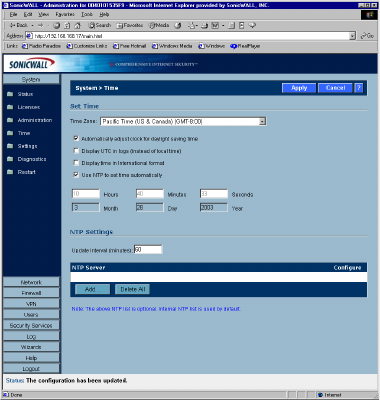
Page 36 SonicWALL SonicOS Standard Administrator’s Guide
Send Syslog Messages in Cleartext Format - Sends Syslog messages as cleartext.
Send Syslog Messages to a Distributed GMS Reporting Server - Sends Syslog Messages to
a GMS Reporting Server separated from the GMS management server.
GMS Reporting Server IP Address - Enter the IP address of the GMS Reporting Server, if the
server is separate from the GMS management server.
GMS Reporting Server Port - Enter the port for the GMS Reporting Server. The default value is
514
6. Click OK.
System>Time
Set Time
The SonicWALL uses the time and date settings to time stamp log events, to automatically update
SonicWALL Security Services, and for other internal purposes. By default, the SonicWALL uses an
internal list of public NTP servers to automatically update the time. Network Time Protocol (NTP) is a
protocol used to synchronize computer clock times in a network of computers. NTP uses Coordinated
Universal Time (UTC) to synchronize computer clock times to a millisecond, and sometimes to a fraction
of a millisecond.
To select your time zone and automatically update the time, choose the time zone from the Time Zone
menu. The Use NTP to set time automatically is activated by default to use the NTP (Network Time
Protocol) to set time automatically. If you want to set your time manually, uncheck this setting. Select the
time in the 24-hour format using the Time (hh:mm:ss) menus and the date from the Date menus.
Automatically adjust clock for daylight saving changes is activated by default to enable automatic
adjustments for daylight savings time.
Selecting Display UTC in logs (instead of local time) specifies the use universal time (UTC) rather than
local time for log events.
Selecting Display time in International format displays the date in International format, with the day
preceding the month.
After selecting your System Time settings, click Apply.
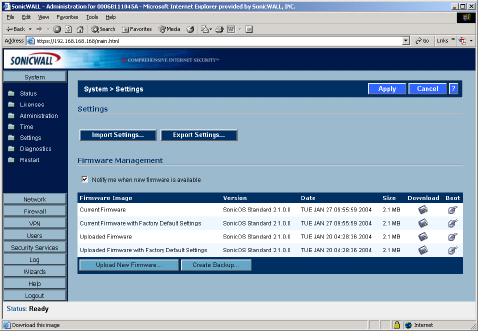
System Settings Page 37
NTP Settings
Network Time Protocol (NTP) is a protocol used to synchronize computer clock times in a network of
computers. NTP uses Coordinated Universal Time (UTC) to synchronize computer clock times to a
millisecond, and sometimes, to a fraction of a millisecond. The SonicWALL use an internal list of NTP
servers so manually entering a NTP server is optional.
Select Use NTP to set time automatically if you want to use your local server to set the SonicWALL
clock. You can also configure Update Interval (minutes) for the NTP server to update the SonicWALL.
The default value is 60 minutes.
To add an NTP server to the SonicWALL configuration, click Add. The Add NTP Server window is
displayed. Type the IP address of an NTP server in the NTP Server field. Click Ok. Then click Apply on
the System>Time page to update the SonicWALL. To delete an NTP server, highlight the IP address and
click Delete. Or, click Delete All to delete all servers.
System>Settings
Settings
Import Settings
To import a previously saved preferences file into the SonicWALL, follow these instructions:
1. Click Import Settings to import a previously exported preferences file into the SonicWALL. The
Import Settings window is displayed.
2. Click Browse to locate the file which has a *.exp file name extension.
3. Select the preferences file.
4. Click Import, and restart the firewall.
Export Settings
To export configuration settings from the SonicWALL, use the instructions below:
1. Click Export Settings.
2. Click Export.
3. Click Save, and then select a location to save the file. The file is named “sonicwall.exp” but can be
renamed.
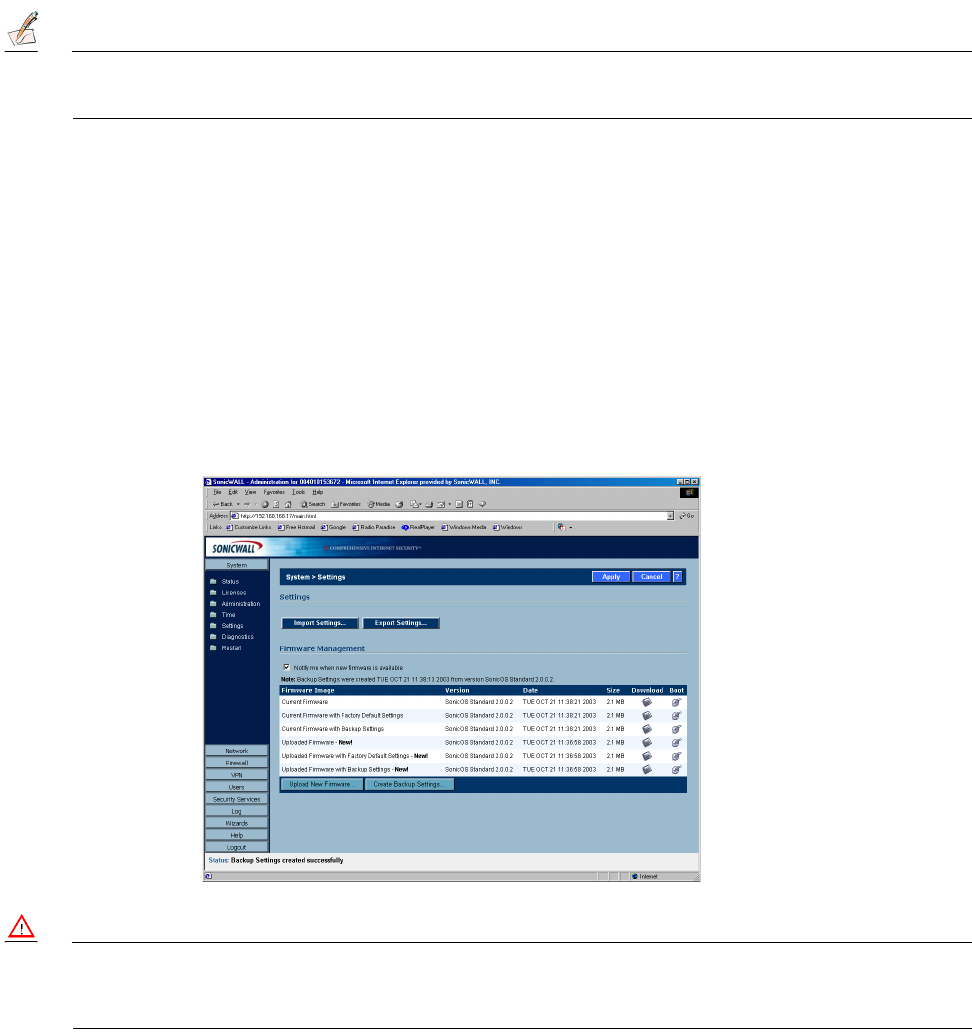
Page 38 SonicWALL SonicOS Standard Administrator’s Guide
4. Click Save. This process can take up to a minute. The exported preferences file can be imported into
the SonicWALL if it is necessary to reset the firmware.
Firmware Management
The Firmware Management section provides settings that allow for easy firmware upgrade and
preferences management. The Firmware Management section allows you to:
• Upload and download firmware images and system settings.
• Boot to your choice of firmware and system settings.
• Manage system backups.
• Return your SonicWALL to the previous system state.
Note:
SonicWALL SafeMode, which uses the same settings used in the Firmware Management section,
provides quick recovery from uncertain states.
New Firmware
To receive automatic notification of new firmware, select the Notify me when new firmware is available
check box. If you enable this feature, the SonicWALL sends a status message to the SonicWALL firmware
server daily with the following information:
•SonicWALL Serial Number
•Product Type
•Current Firmware Version
•Language
•Currently Available Memory
•ROM Version
•Options and Upgrades
Alert!
After the initial 90 days from purchase, firmware updates are available only to registered users with a
valid support contract. You must register your SonicWALL at
<https://www.mysonicwall.com>.
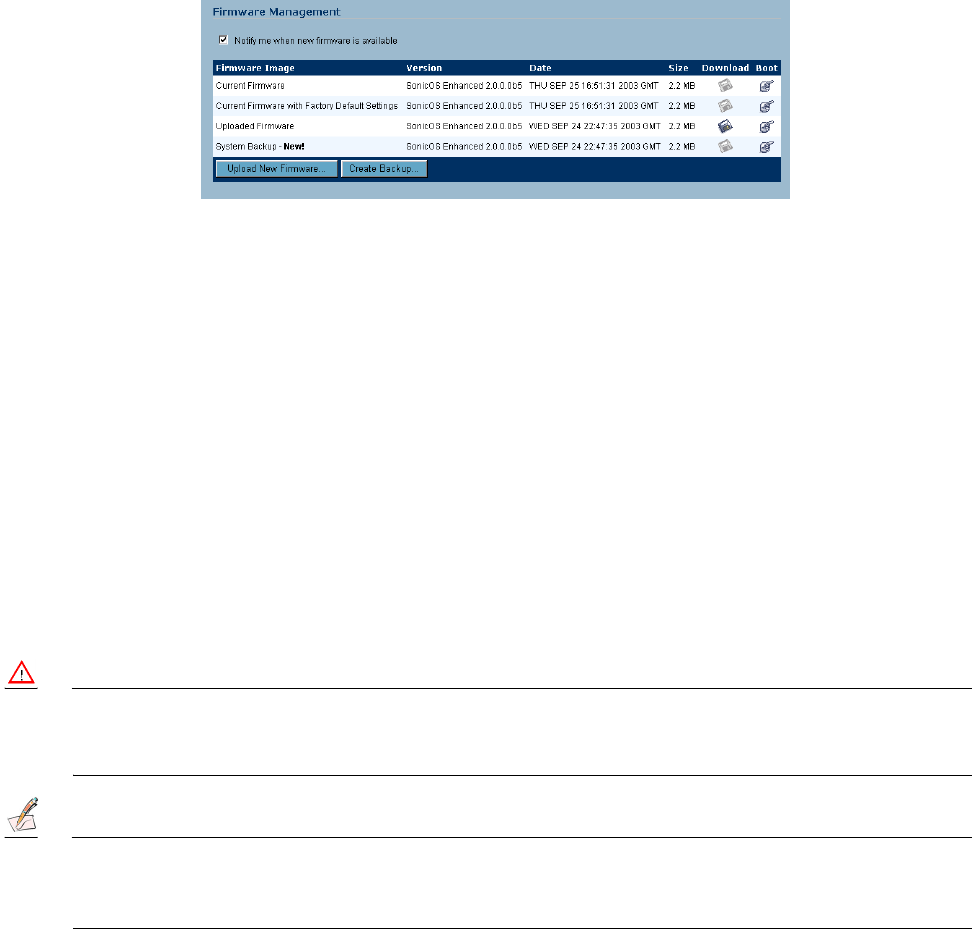
System Settings Page 39
Updating Firmware Manually
Click Upload New Firmware to load new firmware in the SonicWALL. A dialogue box is displayed
warning you that your current firmware version is overwritten by the uploaded version. You should export
your current SonicWALL settings to a preferences file before uploading new firmware. Click Browse to
locate the new firmware version. Once you locate the file, click Upload to load the new firmware onto the
SonicWALL.
Firmware Management Settings
The Firmware Management table has the following columns:
•Firmware Image - In this column, types of firmware images are listed:
- Current Firmware, firmware currently loaded on the SonicWALL
- Current Firmware with Factory Default Settings, rebooting using this firmware image resets the
SonicWALL to its default IP addresses, user name, and password
- Uploaded Firmware, the last version uploaded from mysonicwall.com
- Uploaded Firmware with Factory Default Settings, rebooting using this firmware image resets
the SonicWALL to its default IP addresses, user name, and password
- Current Firmware with Backup Settings, a firmware image created by clicking Create Backup
Settings.
•Version - The firmware version is listed in this column.
•Date - The day, date, and time of downloading the firmware.
•Size - The size of the firmware file in Megabytes (MB).
•Download - Clicking the icon saves the firmware file to a new location on your
computer or network. Only uploaded firmware can be saved to a different location.
•Boot - Clicking the icon reboots the SonicWALL with the firmware version listed in the same row.
Alert!
When uploading firmware to the SonicWALL, you must not interrupt the Web browser by closing the
browser, clicking a link, or loading a new page. If the browser is interrupted, the firmware may become
corrupted.
Note:
Clicking Boot next to any firmware image overwrites the existing current firmware image making it the
Current Firmware image. On the TZ170, the uploaded firmware images are removed from the table after
rebooting the SonicWALL.
SafeMode - Rebooting the SonicWALL
SafeMode allows easy firmware and preferences management as well as quick recovery from uncertain
configuration states. It is no longer necessary to reset the firmware by pressing and holding the Reset
button on the appliance. Pressing the Reset button for one second launches the SonicWALL into
SafeMode. SafeMode allows you to select the firmware version to load and reboot the SonicWALL.
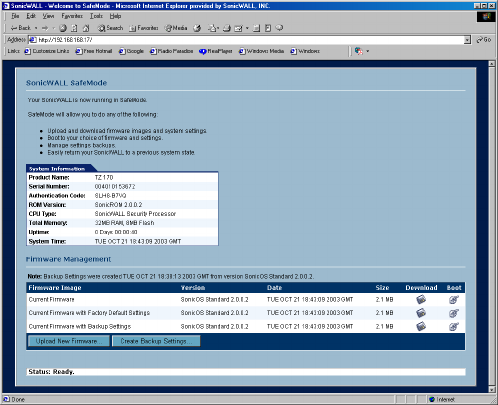
Page 40 SonicWALL SonicOS Standard Administrator’s Guide
Because there are hardware differences between the TZ 170 and the PRO 2040/PRO 3060, Safe Mode
on the TZ 170 cannot store as many firmware images as the PRO 2040/3060. After rebooting, the TZ 170
does not retain uploaded firmware images. To access the SonicWALL using SafeMode, press the Reset
button for 1 second. After the SonicWALL reboots, open your Web browser and enter the current IP
address of the SonicWALL or the default IP address: 192.168.168.168. The SafeMode page is displayed:
SafeMode allows you to do any of the following:
• Upload and download firmware images to the SonicWALL.
• Upload and download system settings to the SonicWALL.
• Boot to your choice of firmware options.
• Create a system backup file.
• Return your SonicWALL to a previous system state.
System Information
System Information for the SonicWALL is retained and displayed in this section.
Firmware Management
The Firmware Management table has the following columns:
•Firmware Image - In this column, five types of firmware images are listed:
- Current Firmware, firmware currently loaded on the SonicWALL
- Current Firmware with Factory Default Settings, rebooting using this firmware image resets the
SonicWALL to its default IP addresses, user name, and password
- Uploaded Firmware, the last version uploaded from mysonicwall.com
- Uploaded Firmware with Factory Default Settings, rebooting using this firmware image resets
the SonicWALL to its default IP addresses, user name, and password
- System Backup, a firmware image created by clicking Create Backup.
•Version - The firmware version is listed in this column.
•Date - The day, date, and time of downloading the firmware.
•Size - The size of the firmware file in Megabytes (MB).
•Download - Clicking the icon saves the firmware file to a new location on your
computer or network. Only uploaded firmware can be saved to a different location.
•Boot - Clicking the icon reboots the SonicWALL with the firmware version listed in the same row.
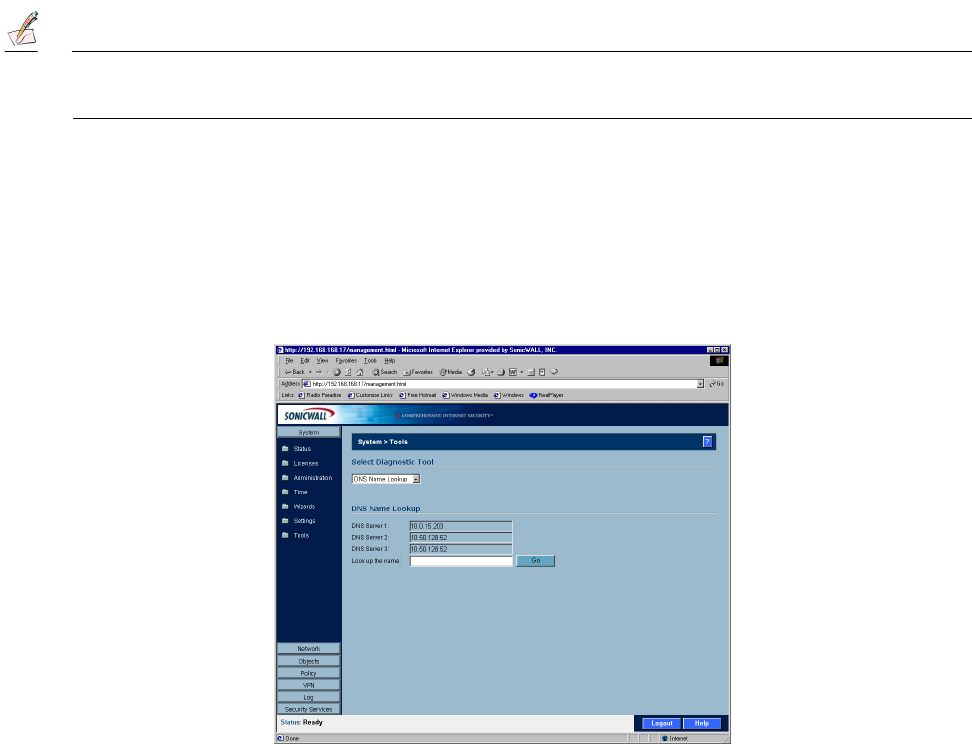
System Settings Page 41
Note:
Clicking Boot next to any firmware image overwrites the existing current firmware image making it the
Current Firmware image.
Click Boot in the firmware row of your choice to restart the SonicWALL.
System>Diagnostics
The SonicWALL has several diagnostic tools which help troubleshoot network problems on the
System>Diagnostics page. You select the diagnostic tool from the menu in the Select Diagnostic Tool
section.
DNS Name Lookup
The SonicWALL has a DNS lookup tool that returns the IP address of a domain name. Or, if you enter an
IP address, it returns the domain name for that address.
1. Enter the host name or IP address in the Look up name field. Do not add http to the host name.
2. The SonicWALL queries the DNS Server and displays the result in the Result section. It also displays
the IP address of the DNS Server used to perform the query.
The DNS Name Lookup section also displays the IP addresses of the DNS Servers configured on the
SonicWALL. If there is no IP address or IP addresses in the DNS Server fields, you must configure them
on the Network>Settings page.
Find Network Path
Find Network Path indicates if an IP host is located on the WAN, OPT/DMZ, or the LAN. This can
diagnose a network configuration problem on the SonicWALL. For example, if the SonicWALL indicates
that a computer on the Internet is located on the LAN, then the network or Intranet settings may be
misconfigured. Find Network Path can be used to determine if a target device is located behind a
network router and the Ethernet address of the target device. It also displays the gateway the device is
using and helps isolate configuration problems.
Page 42 SonicWALL SonicOS Standard Administrator’s Guide
Ping
The Ping test bounces a packet off a machine on the Internet and returns it to the sender. This test shows
if the SonicWALL is able to contact the remote host. If users on the LAN are having problems accessing
services on the Internet, try pinging the DNS server, or another machine at the ISP location. If the test is
unsuccessful, try pinging devices outside the ISP. If you can ping devices outside of the ISP, then the
problem lies with the ISP connection.
1. Select Ping from the Diagnostic Tool menu.
2. Enter the IP address or host name of the target device and click Go.
3. If the test is successful, the SonicWALL returns a message saying the IP address is alive and the time
to return in milliseconds (ms).
Packet Trace
The Packet Trace tool tracks the status of a communications stream as it moves from source to
destination. This is a useful tool to determine if a communications stream is being stopped at the
SonicWALL, or is lost on the Internet.
To interpret this tool, it is necessary to understand the three-way handshake that occurs for every TCP
connection. The following displays a typical three-way handshake initiated by a host on the SonicWALL
LAN to a remote host on the WAN.
1. TCP received on LAN [SYN]
From 192.168.168.158 / 1282 (00:a0:4b:05:96:4a)
To 204.71.200.74 / 80 (02:00:cf:58:d3:6a)
The SonicWALL receives SYN from LAN client.
2. TCP sent on WAN [SYN]
From 207.88.211.116 / 1937 (00:40:10:0c:01:4e)
To 204.71.200.74 / 80 (02:00:cf:58:d3:6a)
The SonicWALL forwards SYN from LAN client to remote host.
3. TCP received on WAN [SYN,ACK]
From 204.71.200.74 / 80 (02:00:cf:58:d3:6a)
To 207.88.211.116 / 1937 (00:40:10:0c:01:4e)
The SonicWALL receives SYN,ACK from remote host.
4. TCP sent on LAN [SYN,ACK]
From 204.71.200.74 / 80 (02:00:cf:58:d3:6a)
To 192.168.168.158 / 1282 (00:a0:4b:05:96:4a)
The SonicWALL forwards SYN,ACK to LAN client.
5. TCP received on LAN [ACK]
From 192.168.168.158 / 1282 (00:a0:4b:05:96:4a)
To 204.71.200.74 / 80 (02:00:cf:58:d3:6a)
Client sends a final ACK, and waits for start of data transfer.
6. TCP sent on WAN [ACK]
From 207.88.211.116 / 1937 (00:40:10:0c:01:4e
To 204.71.200.74 / 80 (02:00:cf:58:d3:6a)
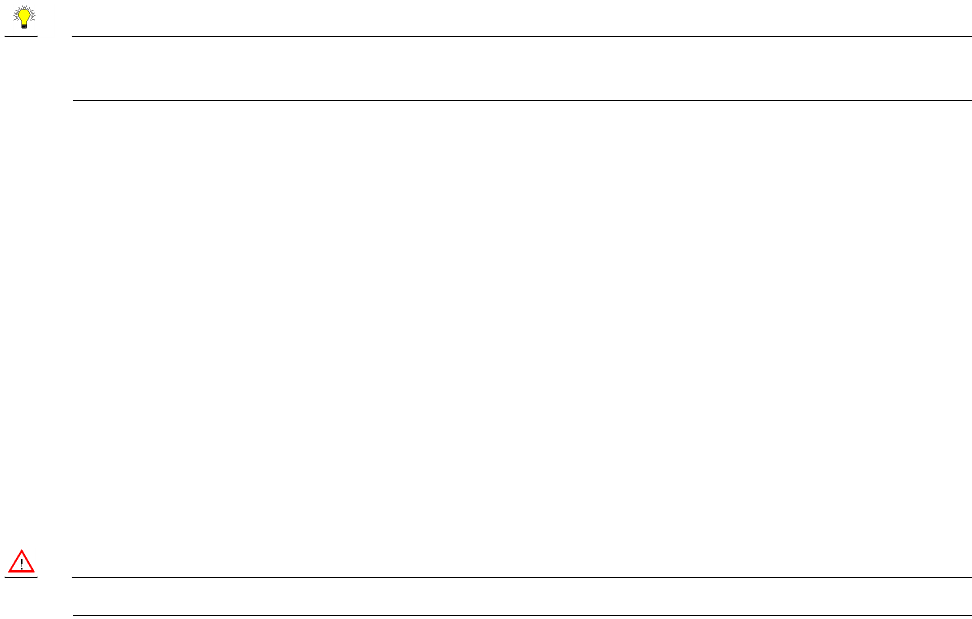
System Settings Page 43
The SonicWALL forwards the client ACK to the remote host and waits for the data transfer to begin.
When using packet traces to isolate network connectivity problems, look for the location where the three-
way handshake is breaking down. This helps to determine if the problem resides with the SonicWALL
configuration, or if there is a problem on the Internet.
Select Packet Trace from the Diagnostic tool menu.
Tip!
Packet Trace requires an IP address. The SonicWALL DNS Name Lookup tool can be used to find the
IP address of a host.
7. Enter the IP address of the remote host in the Trace on IP address field, and click Start. You must
enter an IP address in the Trace on IP address field; do not enter a host name, such as
“www.yahoo.com”. The Trace is off turns from red to green with Trace Active displayed.
8. Contact the remote host using an IP application such as Web, FTP, or Telnet.
9. Click Refresh and the packet trace information is displayed.
10. Click Stop to terminate the packet trace, and Reset to clear the results.
The Captured Packets table displays the packet number and the content of the packet, for instance, ARP
Request send on WAN 42 bytes.
Select a packet in the Captured Packets table to display packet details. Packet details include the packet
number, time, content, source of the IP address, and the IP address destination.
Tech Support Report
The Tech Support Report generates a detailed report of the SonicWALL configuration and status, and
saves it to the local hard disk. This file can then be e-mailed to SonicWALL Technical Support to help
assist with a problem.
Alert!
You must register your SonicWALL on mySonicWALL.com to receive technical support.
Before e-mailing the Tech Support Report to the SonicWALL Technical Support team, complete a Tech
Support Request Form at <https://www.mysonicwall.com>. After the form is submitted, a unique case
number is returned. Include this case number in all correspondence, as it allows SonicWALL Technical
Support to provide you with better service.
In the Tools section, select Tech Support Report from the Select a diagnostic tool menu. Four Report
Options are available in the Tech Support Report section:
•VPN Keys - saves shared secrets, encryption, and authentication keys to the report.
•ARP Cache - saves a table relating IP addresses to the corresponding MAC or physical addresses.
•DHCP Bindings - saves entries from the SonicWALL DHCP server.
•IKE Info - saves current information about active IKE configurations.
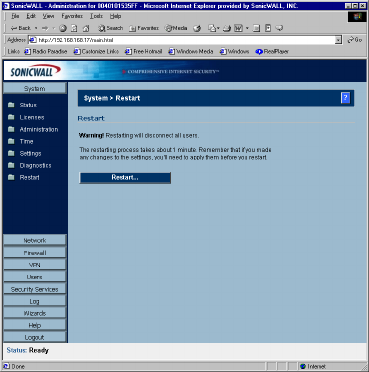
Page 44 SonicWALL SonicOS Standard Administrator’s Guide
Generating a Tech Support Report
1. Select Tech Support Report from the Choose a diagnostic tool menu.
2. Select the Report Options to be included with your e-mail.
3. Click Save Report to save the file to your system. When you click Save Report, a warning message
is displayed.
4. Click OK to save the file. Attach the report to your Tech Support Request e-mail.
Trace Route
Trace Route is a diagnostic utility to assist in diagnosing and troubleshooting router connections on the
Internet. By using Internet Connect Message Protocol (ICMP) echo packets similar to Ping packets, Trace
Route can test interconnectivity with routers and other hosts that are farther and farther along the network
path until the connection fails or until the remote host responds.
Enter the IP address or domain name of the destination host. For example, enter yahoo.com and click Go.
A second window is displayed with each hop to the destination host.
By following the route, you can determine where the connection fails between the SonicWALL and the
destination.
System>Restart
Click Restart to display the System>Restart page. The SonicWALL can be restarted from the Web
Management interface. Click Restart SonicWALL and then click Yes to confirm the restart.
The SonicWALL takes approximately 60 seconds to restart, and the yellow Test light is lit during the
restart. During the restart time, Internet access is momentarily interrupted on the LAN.
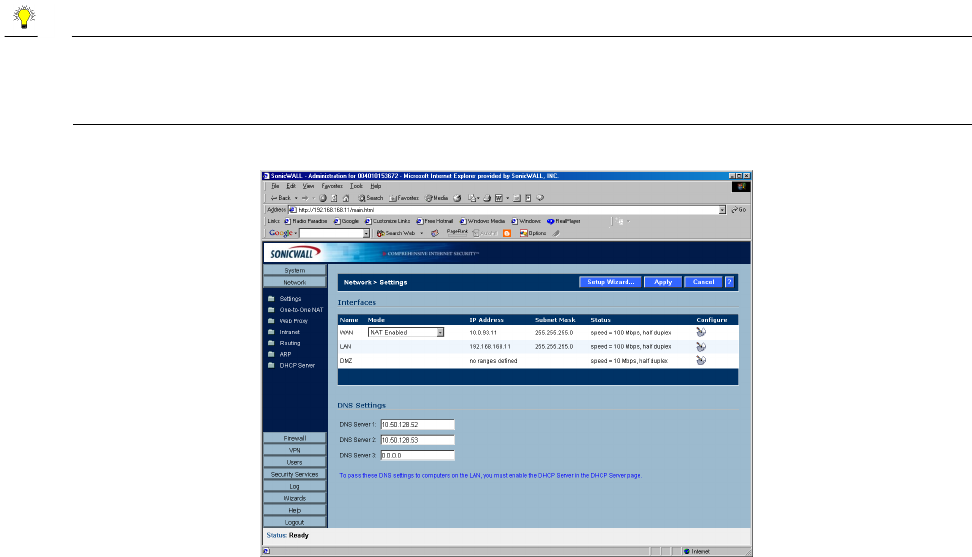
Network Page 45
4 Network
This chapter describes the Network section of the management interface and the configuration of the
SonicWALL Internet Security appliance Network settings. The Network menu includes
•Settings - select your network mode and manually configure the network settings on the SonicWALL.
•One-to-One NAT - map internal IP addresses to public IP addresses using One-to-One NAT.
•Web Proxy - A Web proxy server intercepts HTTP requests and determines if it has stored copies of
the requested Web pages. If it does not, the proxy completes the request to the server on the Internet,
returning the requested information to the user and also saving it locally for future requests.
•Intranet - The SonicWALL can be configured as an Intranet firewall to prevent network users from
accessing sensitive servers.
•Routing - view the Route Table, ARP Cache and configure Static Routes.
•ARP - view the ARP settings and clear the ARP cache as well as configure ARP cache time.
•DHCP Server - configure the SonicWALL as a DHCP Server on your network to dynamically assign
IP addresses to computers on your network.
Network>Settings
The Network>Settings page allows you to configure the your network and Internet connectivity settings.
You can configure your WAN (Internet), LAN, and DMZ interfaces.
Tip!
If you are unsure about configuring network settings manually, click Setup Wizard. The Setup Wizard
offers a easy-to-use method for configuring your SonicWALL. See Chapter 2 for complete Setup
Wizard instructions.